How to trek to Everest Base Camp

Jun 20, 2023 • 10 min read
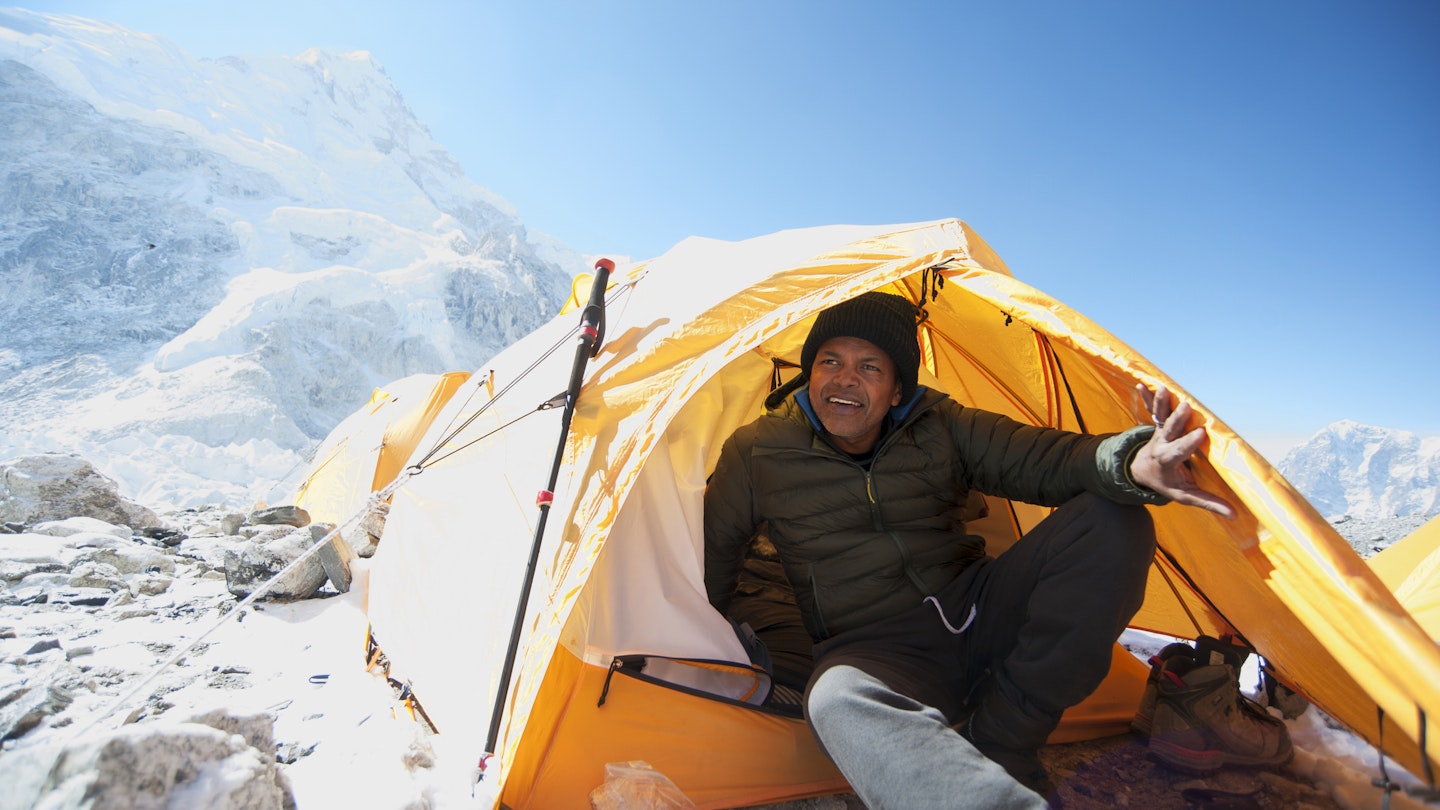
From permits to teahouses, here's everything you need to know about trekking to Everest Base Camp © Mint Images / Getty Images
Top of many people's travel bucket lists, the trek to Everest Base Camp is often the first thing people think about when they start dreaming of a trip to Nepal .
The walk takes trekkers past Sherpa villages and Tibetan-style monasteries, right up into the heart of the high Himalaya, into a breathtaking world (literally) of iconic glaciers, lakes and the tallest peaks on earth. It's probably the world's most famous trek.
But what is it actually like to trek to Base Camp? Is it something within your capabilities or budget? What should you bring? And, most importantly, can you get a proper coffee en route?
I just returned from trekking to Everest Base Camp for Lonely Planet's Nepal guide . Here’s what I think you need to know.
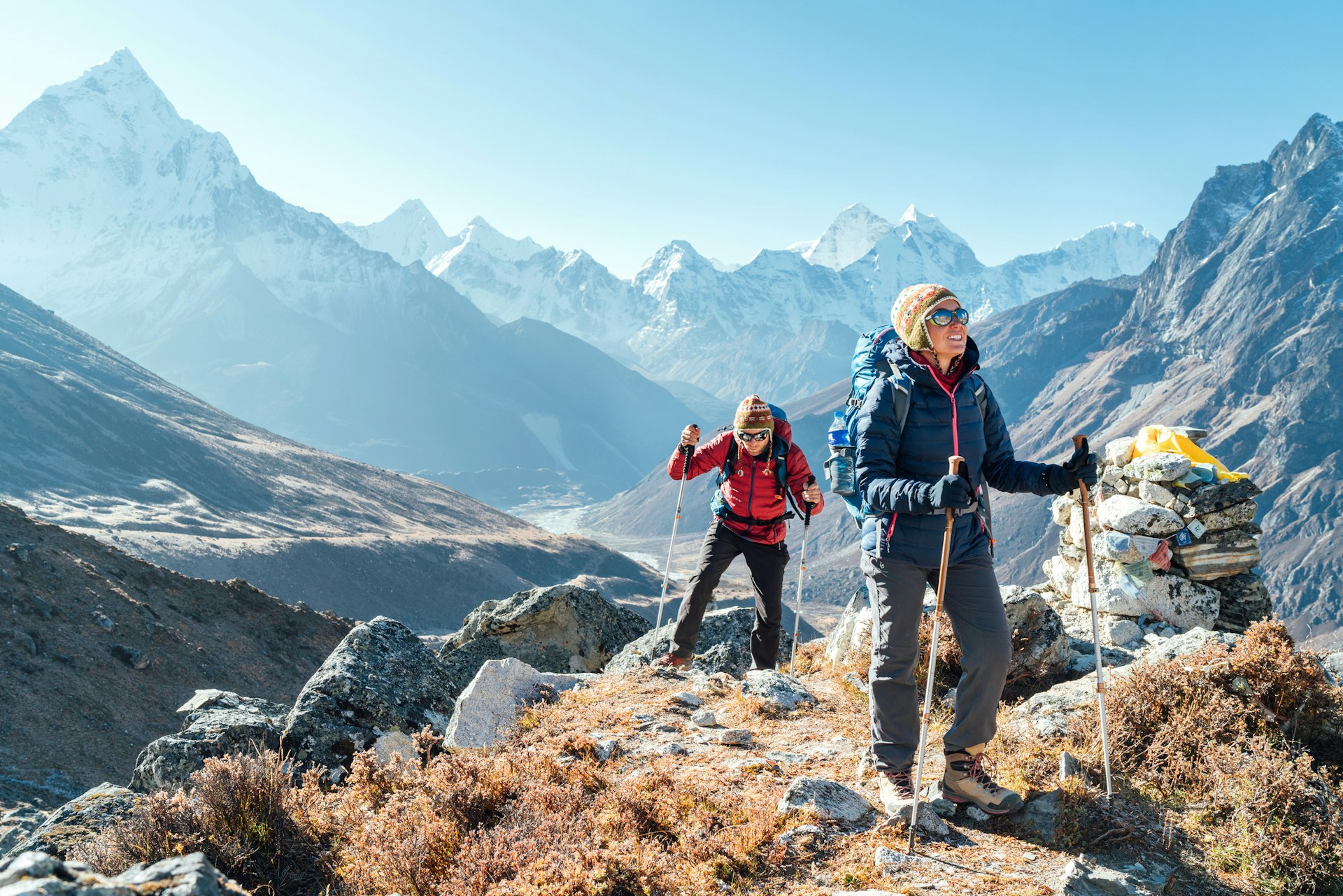

What's so great about the Everest Base Camp (EBC) trek anyway?
Firstly, the mountain scenery surrounding the world's highest peak is truly spectacular. The sublime views of Ama Dablam, Pumori, Nuptse and Thamserku peaks are unbeatable and constantly change as you progress along the walk. The Sherpa villages and monasteries are fascinating places to visit and the lodges (called teahouses) are the best in the world.
The knowledge that you are walking in the expedition footsteps of Hillary, Tenzing, Messner and others is a thrill. Anyone who has read Into Thin Air will be moved by the memorial stupas of Rob Hall, Scott Fischer and others who have lost their lives on the mountain. And then there's the fact that you will have reached the base of the world's highest peak; whether you call it Chomolongma (Tibetan), Sagarmatha (Nepali) or Everest, it’s a rush all the same.
And what’s not so great about the Everest Base Camp trek?
Well, if you force us to play devil's advocate… EBC is one of the busiest trails in Nepal. In the high season months of October and November you'll be walking with thousands of other trekkers, competing with them to get a bed, a lunch order or an airplane seat. There will be lines at checkpoints and even at moments on the trail itself. In bad weather you might be stranded at Lukla airport with hundreds of other trekkers, all trying to get on the first flight out. It's not quite the Zen-like wilderness experience you may have been imagining.
Bear in mind also that even after a solid week of walking, your view of Everest will be partial at best (for infinitely more dramatic Everest views visit the northern Everest Base Camp in Tibet ). If you trek outside of May's expedition weather window you won’t actually find much to see at Base Camp beyond a boulder hastily spray-painted with "Everest Base Camp".
If this has put you off, don’t worry; there are dozens of other fantastic treks in Nepal .
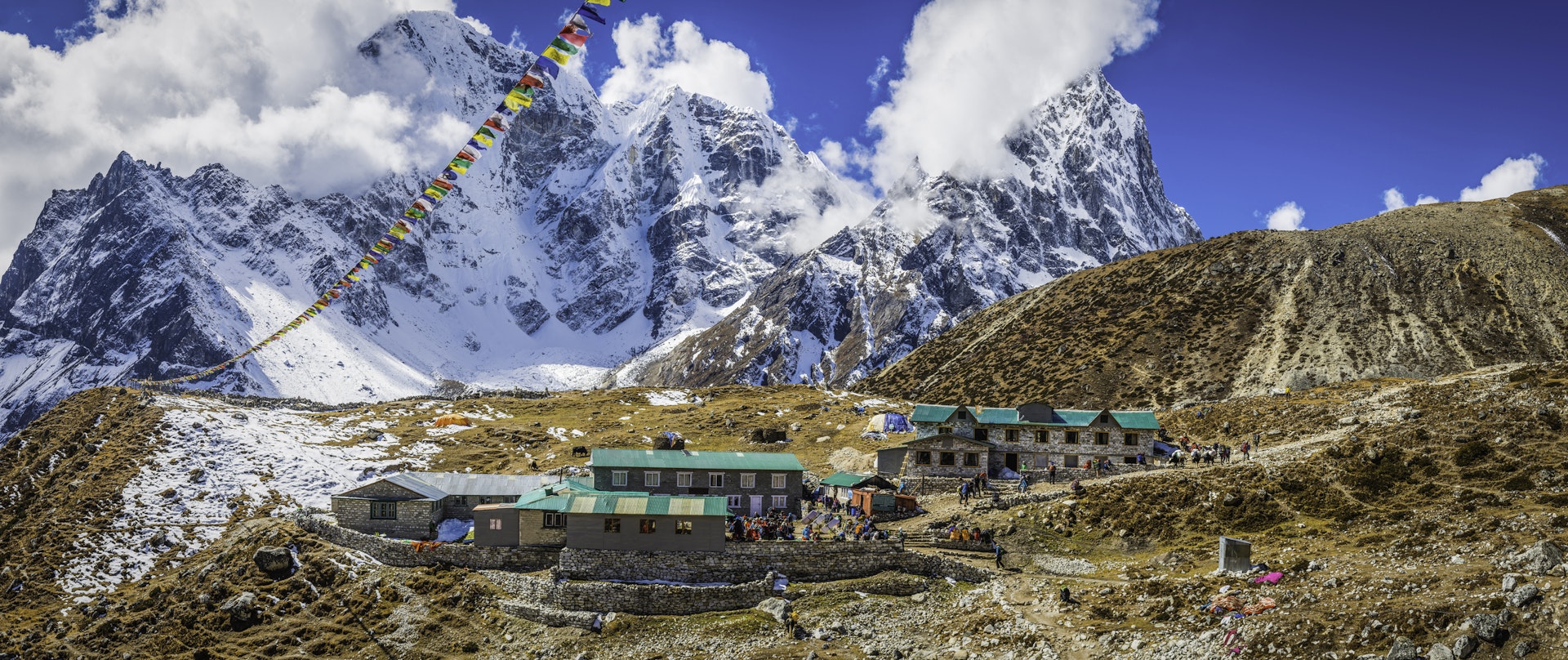
How long does it take to trek to Everest Base Camp?
The walk from the airport at Lukla to Everest Base Camp and back takes a minimum of 15 days. Several of the days are surprisingly short, but this is because you have to figure in time to acclimatize to the high altitudes.
If you can, it's definitely worth adding on a couple of extra days to this basic itinerary. Some of the most dramatic (and least visited) views are from detours off the main trail. I always add two days to visit Thame, two days to visit Chhukung and, if possible, three or four days to visit the lakes of the Gokyo Valley – probably the most beautiful scenery in the Everest region.
Be sure to also budget an extra day or two as a transport buffer. Weather-related flight delays in and out of Lukla are not uncommon (I had to wait six days for a flight to Lukla on my recent trip) so you need some buffer time if heading back for an international flight home.
How challenging is the trek to EBC?
In terms of physical effort, the EBC trek itself is not especially tough. There are only a couple of steep climbs, lasting about an hour each, and most days involve less than four hours of walking.
The thing that makes the EBC trek tough is the altitude. Base Camp is at 5600m (18,373ft) and you will need to spend one or two nights above 5000m (16,404ft). Above 4000m (13,123ft) you are going to feel increasingly lethargic and out of breath as the amount of oxygen in the air decreases. Combine this with the cold, the discomfort of being at altitude and the compounded tiredness from walking for two weeks straight, and you can see why the whole trek experience is definitely a physical challenge.
While you don't need to be an athlete to walk to EBC it is still a good idea to start a fitness regime in the weeks leading up to your trek. You'll enjoy the walk so much more if you are in decent shape.
When is the best time to trek to Everest Base Camp?
October and November bring the best weather and the clearest skies but these are also the most popular months. The second most popular season is April to early May, when spring blooms and expedition traffic bring extra interest to the trail. To avoid the crowds but still enjoy clear views, pack an extra thermal layer and come in December or March.
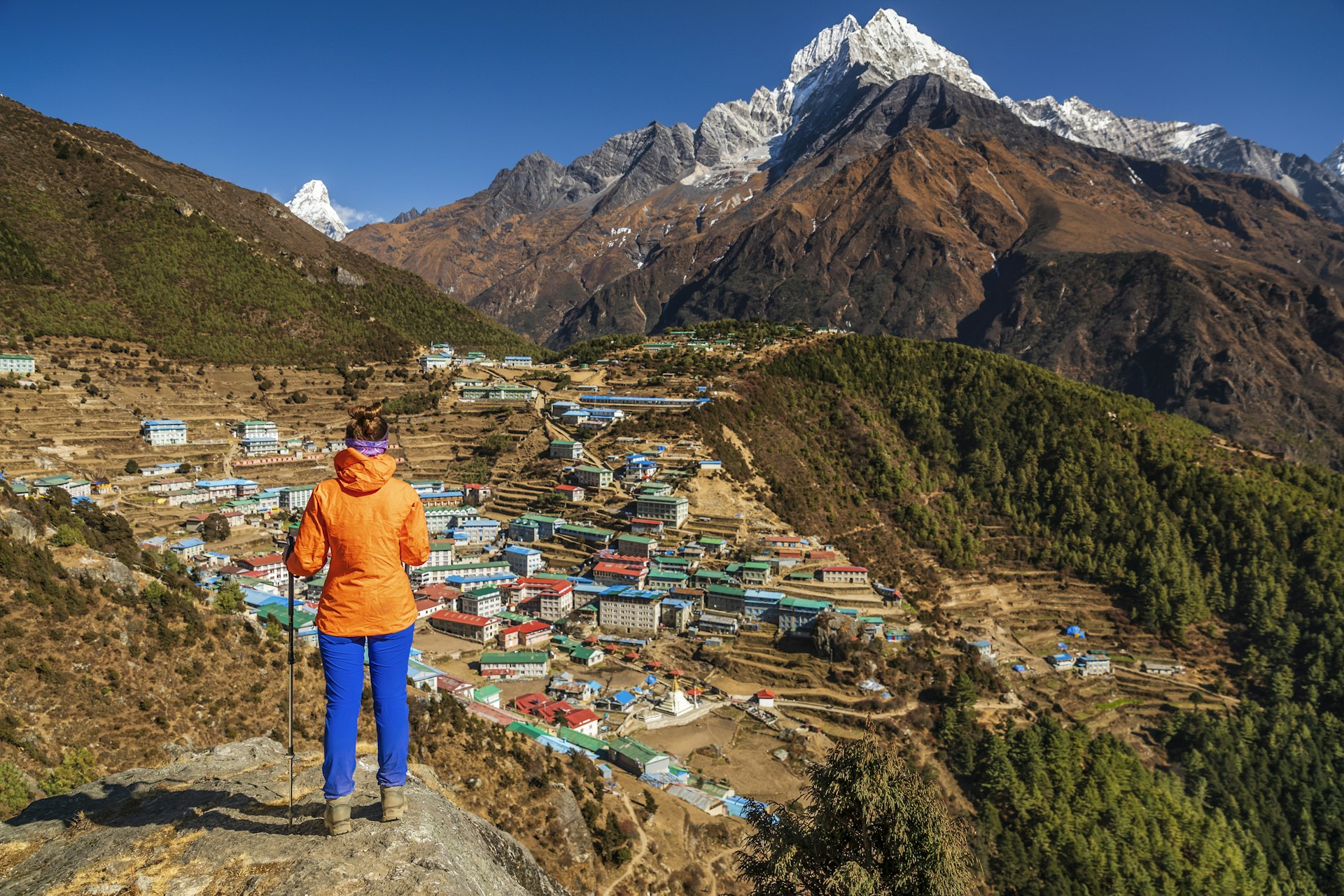
What can I do to avoid altitude sickness?
The majority of people who fail to reach Base Camp do so because they failed to acclimatize properly to the altitude. It's essential not to gain altitude too quickly by following the recommended overnight stops and limiting your daily altitude gain to a maximum of 400m (1312ft) when above 3000m (9843ft).
Be sure to add in acclimatization days at both Namche Bazaar and Dingboche, during which it's a good idea to hike to higher altitudes during the day, returning to sleep lower at night.
What are the teahouses like?
At lower altitudes the Everest lodges are the most comfortable in Nepal. Private rooms are the norm, many of which have private bathrooms. Showers are available at most places, though the hot water supply can be patchy. All have cozy dining rooms with tables arranged around a central dung-fueled stove. There are even a few luxury lodges along the trail.
In budget lodges, or when you get above Dingboche, things get simpler, with rooms offering little more than a collection of plywood walls, a solar light and a foam mattress. Toilets are a mixture of seats and squatters; sometimes outdoors, always freezing. A blanket is normally supplied but be sure to bring a four-season sleeping bag rated to well below 0°C (32°F).
What's the food like?
Menus in teahouses range from pasta and pizza to spring rolls, fried potatoes and soups, though the most popular meal is a daal bhaat , a set Nepali meal of rice, lentil soup and fried vegetables, normally served with a papad and pickle, and with a refill included. It's the most filling and environmentally sustainable meal you can order.
In villages such as Namche Bazaar and Dingboche you will also find bakery-cafes serving espresso and slices of delicious apple pie, plus shops selling everything from Snickers bars to bottles of beer. This is one trek where you might actually gain weight!
Can I get wi-fi or phone coverage?
Most lodges offer wi-fi, either free of charge or for a few dollars per day (at higher elevations). Above Namche Bazaar you will likely have to buy a scratch card, giving you unlimited data for twelve hours (AirCell) or a specific amount of data over a month (Everestlink). Depending on your network provider you'll likely get data and a phone signal at lower elevations, and possibly even at Everest Base Camp, but not at other high altitudes. So yes, in theory, you can Skype all your friends from Base Camp!
What should I bring?
Warm clothes are a must, and you should pack thermal underwear, a down jacket and fleece hat. Comfortable hiking boots and good, padded socks are also essential. Sun block, a sun hat with a brim and good sunglasses are important against the strong high-altitude light.
Morale-boosting snacks like chocolate and salami are always helpful, as is a book and smartphone with mapping software like Maps.me. Bring water purification of some sort. If you forget something, don’t worry, you can buy almost anything you might want in Namche Bazaar these days (from ice axes to cans of Pringles), though at prices higher than in Kathmandu .
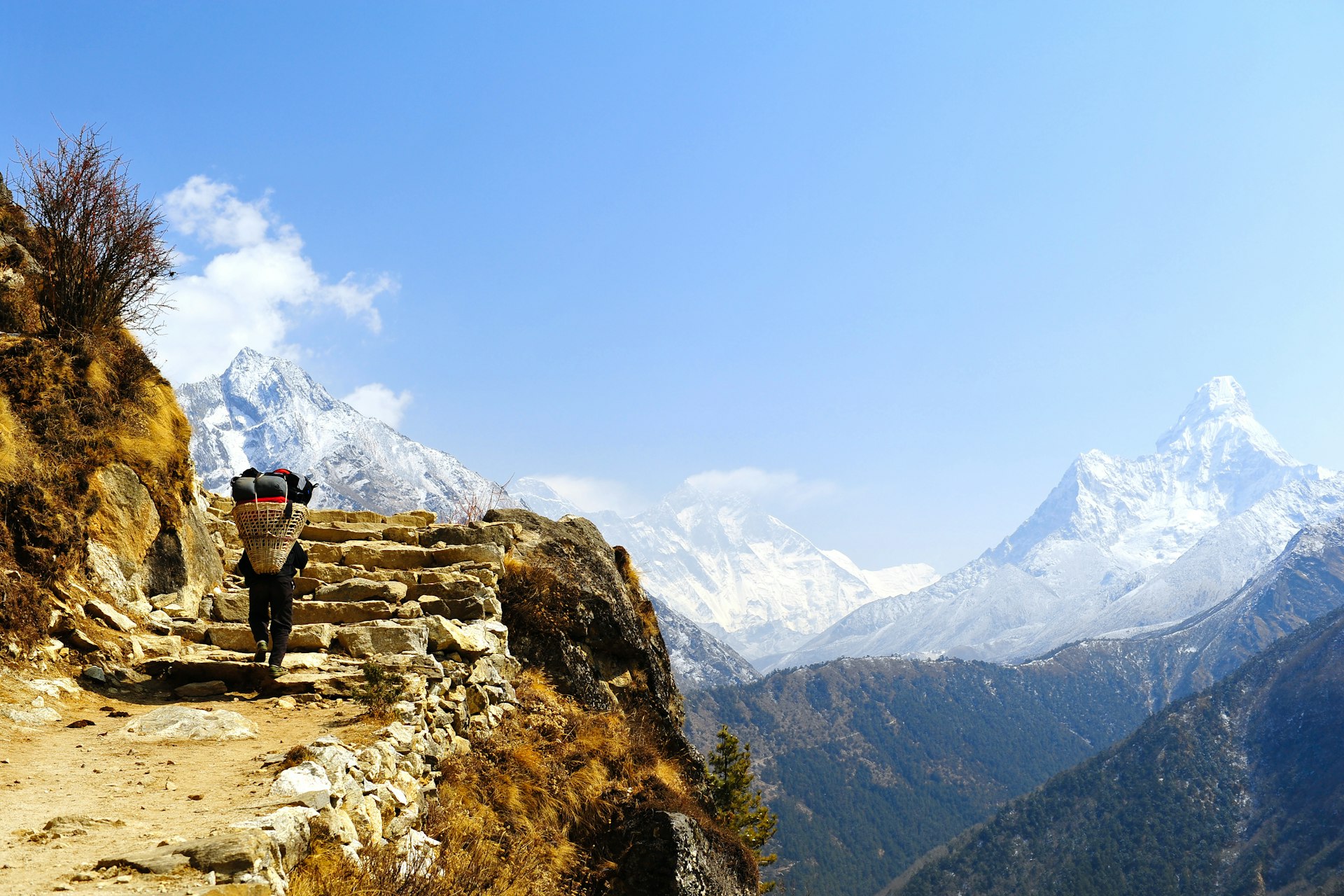
Do I need a porter and guide?
In terms of finding your way you don't need a guide if you are an experienced walker, as the route is clearly marked and well-trod. A guide can be useful for smoothing your way at teahouses, making sure you get your food on time and helping you pay your bill. It's important not to trek alone, so solo trekkers should find a companion or take a guide or porter.
A porter will carry a bag of around 15kg, freeing you up to pack a few extra chocolate bars and enjoy the walk with little more than a day pack. Not having the strain of carrying a full pack is worth its weight in gold for anyone over the age of 50. Trust me.
How much does the Everest Base Camp trek cost?
For a room in a lodge and three meals a day, figure on US$20–25 per person per day, a bit more if you want a room with a private bathroom and the occasional slice of apple pie. Add on another US$5 every time you want a shower. Figure on an additional US$20 per day for a porter, and US$25–30 for a guide, and budget 10–15% of that fee for an end-of-trip tip.
You'll pay a bit more to have a Kathmandu-based trekking company arrange your entire trek, and a lot more for the convenience and backup of an international trekking tour.
Do I need any permits?
You will need to buy an Everest region permit (US$20) at Lukla, as well as a Sagarmatha National Park entry ticket (US$30) at Monjo. Currently that's all you need.
How can I trek more sustainably?
With 60,000 trekkers and guides headed to the Everest region, it’s important to minimize your impact on the region. Firstly, don't buy bottled water on the trek, as the bottles are nonrecyclable and are a huge problem throughout the region. Bring a system of water purification, like a Lifestraw or Sawyer filter, a Steripen or chemical purification.
Secondly, carry all your trash out (especially batteries), and sign up for the Carry Me Back program, whereby you carry a 1kg bag of trash from Namche Bazaar to Lukla, for it to be recycled in Kathmandu.
Finally, be polite to the Sherpas and porters you meet en route, as well as your fellow trekkers. Walk clockwise around stupas and be respectful at monasteries and shrines.
How do I get to Lukla to start the trek?
Flights run multiple times daily between Kathmandu and Lukla, taking around 30 minutes. During high season however you may have to drive five hours from Kathmandu to Ramechhap airport to catch your Lukla flight there.
It's also possible to fly or drive to Phaplu and walk two days to Lukla from there, or walk from Shivalaya to Lukla in seven days as an excellent pre-trek warm-up.
This article was first published Jan 14, 2013 and updated Jun 20, 2023.
Explore related stories
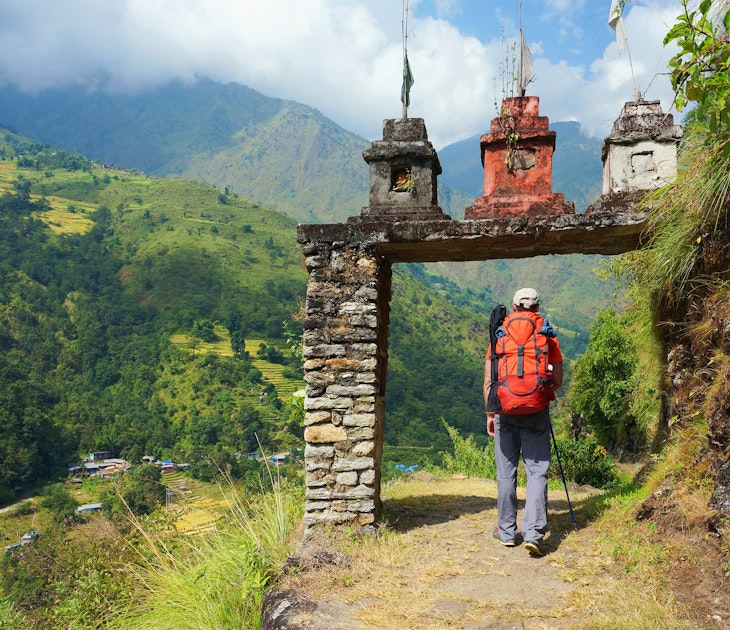
Mar 14, 2023 • 4 min read
To reduce accidents and promote jobs, Nepalese authorities recently announced a ban on solo trekking in national parks and conservation areas.

Jul 13, 2022 • 8 min read

Jan 31, 2022 • 6 min read
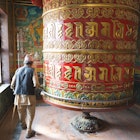
Jan 9, 2022 • 8 min read

Sep 14, 2021 • 11 min read

Jan 28, 2021 • 5 min read
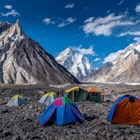
Jan 12, 2021 • 7 min read
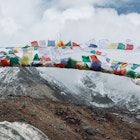
Dec 10, 2020 • 6 min read
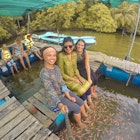
Jan 7, 2020 • 6 min read
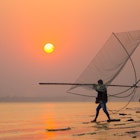
Oct 10, 2019 • 9 min read
- Travelogues
- Travel Agent Cooperation
.jpg)
17 Things to Know Before Visiting the Everest Base Camp of Tibet
Traveling to the Everest Base Camp in Tibet is no ordinary feat. It is a travel goal for many and demands careful planning and preparation - financial, physical, or mental. That's where our comprehensive guide comes in – to help you maximize this bucket-list adventure.
Standing at the foot of the majestic Mount Everest and witnessing the breathtaking beauty of the 'roof of the world,' we don't want you to feel that you are missing out on anything or are overwhelmed with unsavory surprises.
From on-ground experience to first-hand knowledge and practical advice, we will cover everything you need to know before setting foot on this inspirational journey. Let's dive in and get you ready for the experience of a lifetime at Everest Base Camp in Tibet!

1. No Matter When you Visit the Everest Base Camp of Tibet, a Down Jacket is Always Necessary
Situated at an altitude of 5200m, Everest Base Camp is always cold, though the weather in Everest Base Camp varies throughout the year. From April to early June and September to November, the preferred months to make the Everest Base Camp tour, the daytime temperature can reach 15°C but drops to below zero at night. During the winter months of November to March, the nighttime temperatures are around -15°C and daytime temperatures at -5°C.
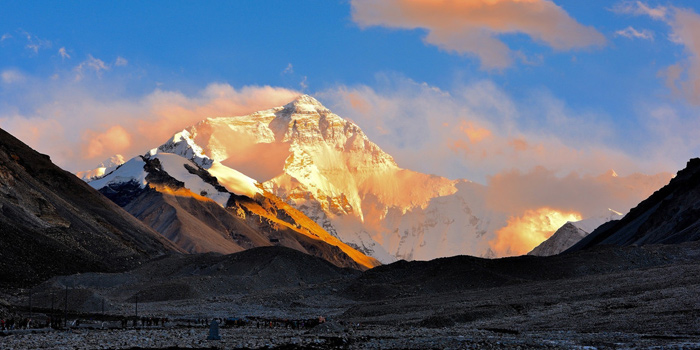
8 Days Lhasa to Everest Base Camp Small Group Tour
So whenever you visit, keeping warm is essential. Down jackets are superb insulators that can easily regulate your core temperature to keep you comfortable in sub-zero temperatures. Taking care of your throat, head, and torso is essential to avoid catching a cold at a high altitude.
2. There is a Speed Control, so It Takes a Long Drive to Arrive at the Everest Base Camp of Tibet
Though the distance from Lhasa to Everest Base Camp is only 720 km, there are strict speed limits for safety reasons to make the going slow. Typically, tour vehicles travel 80 km/h on expressways, 70 km/h on national highways, and 30 km/h when passing bends. For instance, the 270-kilometer journey from Lhasa to Shigatse takes around 5 to 6 hours due to the speed limits. Download podcasts and carry motion sickness medicines to keep the car ride comfy.
3. Actually, the Mt.Everest Shows Much More Clear in Winter
With no cloud cover and low to no precipitation, winter days give constant sunshine, clear visibility, and the magical snow-covered landscape composition of Mt. Everest. The days have clear deep blue sky, and the night creates a mesmerizing atmosphere with the star-studded Milkyway. Mount Everest's iconic peak stands glorious, with a golden sunrise and sunset glow, making it even more magnificent than during the peak tourist season. So if you are planning to tour Tibet in winter , consider adding Everest Base Camp to your itinerary. It will be a fantastic addition to your travel list.
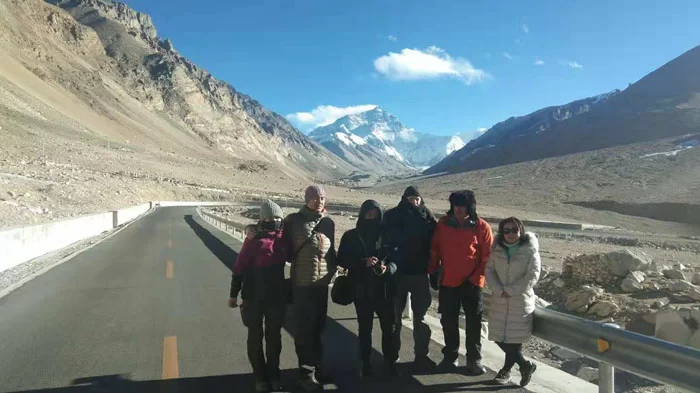
4. The Accommodations and Dining in Everest Base Camp of Tibet Improves a Lot in Recent Years
Accommodations at Everest Base Camp include two primary options: tented guest houses set up by local Tibetans and the Rongbuk Monastery guesthouse. The former offers an authentic experience of Tibetan nomadic life and provides basic but comfortable beds with simple meals. Rongbuk Monastery guesthouse has better facilities like electric blankets, power sockets, twin rooms, and a dining room serving simple Chinese and Tibetan dishes and beverages like milk and hot water. Other accommodation options near Everest Base Camp include guest houses in Tashi Dzom and hotels in Old Tingri, where you will find more facilities like running water and electricity.
5. There are No Age-Limits for Visiting the Everest Base Camp of Tibet
Yes, you read that right! We have had various remarkable clients proving that age is not an obstacle. The oldest clients we received were an 82-year-old German traveler Gerhard and an 84-year-old American lady Anne Gentry who successfully reached Everest Base Camp. On the other hand, we had a Swiss family visiting Everest Base Camp with their two boys, aged 6 and 4, making them the youngest clients at Mt. Everest.
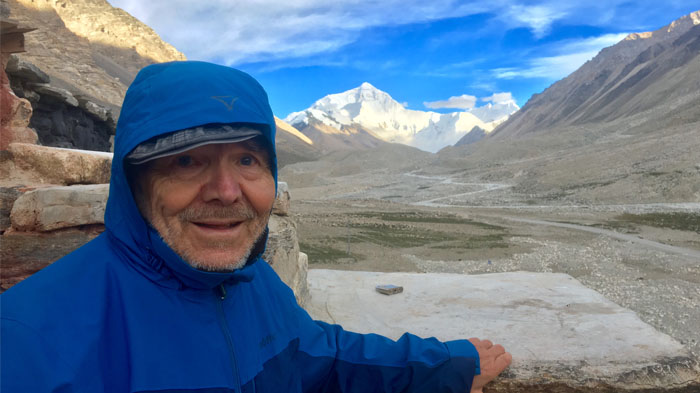
But it's essential to consider individual health conditions and consult a doctor, especially for those above the age of 80 or below the age of 7, due to the high altitude's potential impact on the body's ability to adapt.
6. These People Couldn’t Travel to the Everest Base Camp of Tibet
While Everest Base Camp in Tibet is theoretically open to all kinds of people, certain health conditions may prevent individuals from traveling to extreme altitudes (5200m) and most parts of Tibet for safety reasons.
People with certain medical conditions, such as heart disease, severe arrhythmia, hypertension, cranial vascular diseases, and emphysema, are advised not to travel to Tibet, including the Everest Base Camp, due to the potential risks associated with high altitude.
Additionally, it is not recommended for small children under the age of 7 to undertake the Everest Base Camp tour due to the challenges and potential health risks posed by the high-altitude environment.
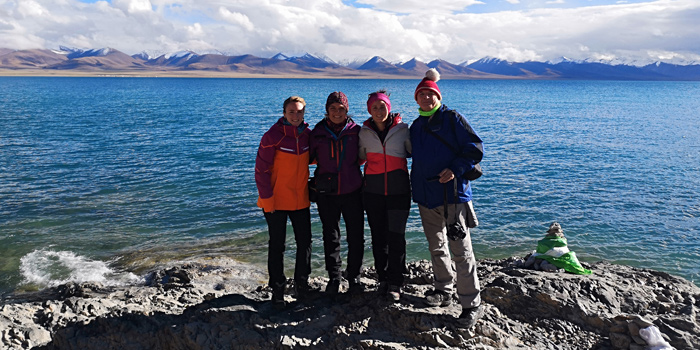
10 Days Lhasa to EBC and Namtso Lake Small Group Tour
7. these are the best places to shoot the mt.everest, except for the everest base camp.
Apart from the Everest Base Camp, there are three excellent places to photograph Mount Everest in all its majesty and mysticism. Gawula Pass, on the way to Everest Base Camp, offers panoramic views of Mount Everest, Makalu, Lhotse, Cho Oyu, and Shishapangma. The undulating landscape and winding roads add another dimension to the scenery. Old Tingri provides a clear view of Everest from a distance at a lower altitude than Everest Base Camp. Rongbuk Monastery is not only a creative foreground for capturing the stunning Everest summit but also a night joint to do astrophotography as light pollution is absent. Composing sunrise shots over the Mt. Everest peak from here is every photographer’s dream.
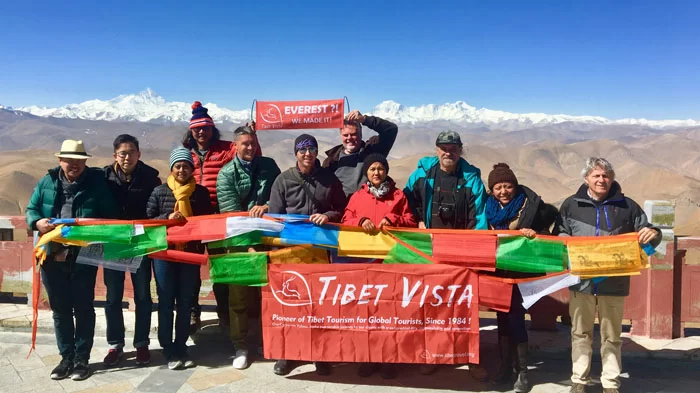
8. Prepare the Oxygen Supply When Taking the Everest Base Camp of Tibet
While on the Everest Base Camp tour in Tibet , it is essential to be prepared for the high-altitude environment. Oxygen supply is crucial for coping with the thin air at such elevations. Portable oxygen bottles are provided to ensure the safety and well-being of travelers during the journey. Experienced tour guides organize the oxygen supply and carry blood-oxygen-saturation-level meters to monitor each tourist's health throughout the trip. They are well-trained to respond to health concerns and provide assistance when needed.
9. Pack Chocolate And Any Extra Treats that You Want
Whether traveling overland from Lhasa to Everest Base Camp or trekking from Tingri, the trip can be energy-consuming, making snacks like chocolate, sugar, and energy bars a helpful source of sustenance. Also, at Everest Base Camp, options are limited, and packet foods are priced higher due to the challenging logistics of transporting food to high altitudes. So, it is wise to pack instant food such as self-heating rice, bread, and easily digestible biscuits.
10. The Sunset is Stunning, but Also Never Miss out the Starry Night of Everest Base Camp
If you thought dipping daylight has ended your photographing opportunities at Everest Base Camp, you have not looked up yet. The sunset and sunrise are stunning, but nightsky has its own magic. Thanks to its high altitude, pure air, and lack of light pollution, the Everest Base Camp in Tibet is an ideal spot to witness the dazzling galaxy and stars.
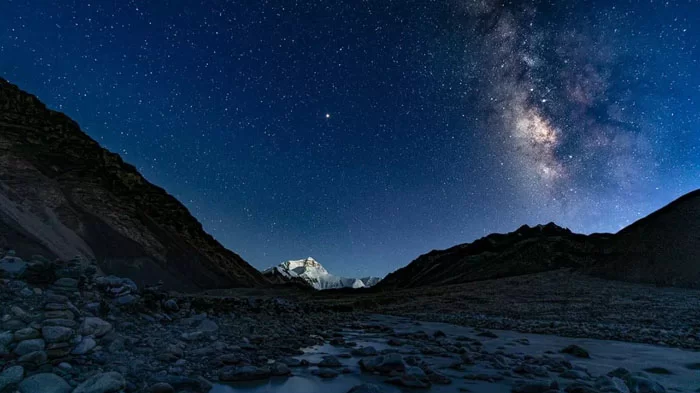
From April to June, you can experience the most spectacular views of the starry sky when the stars glow with different colors and the Milky Way is laid out like a mystical arrangement of celestial lights. Climbing the nearby hill offers an even better view, or you can also photograph the sky from the Rongbuk Monastery.
11. Rongbuk Glacier around Everest Base Camp is Not Available to Visit Unless You Prepare in Advance
Though the majestic Rongbuk Glacier in Tibet is approximately a 4-hour walk away from Everest Base Camp, visiting the glacier requires advance preparation and special permits. Approaching a place higher than Everest Base Camp is considered mountaineering, mandating a permit from Tibet Mountaineering Association. The activity is costly and takes 3 days to reach. Everest Base Camp tickets do not grant access to these areas, so proper planning and permits are essential.

12. Rongbuk Monastery at the Everest Base Camp is the World’s Highest Monastery
Situated at 5,009m (16,434ft) above sea level, at the foot of Rongbuk Glacier, Rongbuk Monastery is the world's highest monastery. The summit of Mount Everest is approximately 25 kilometers away, and the Everest Base Camp is only 8 kilometers from here. This five-storeyed monastery's large chorten creates a fascinating photo frame with Mt. Everest as the backdrop. During the Saga Dawa festival, the monastery hosts Buddhist dancing ceremonies and other grand celebrations. It is connected to Shigatse City and Lhasa by road, and visitors can stay overnight, but the facilities are basic.
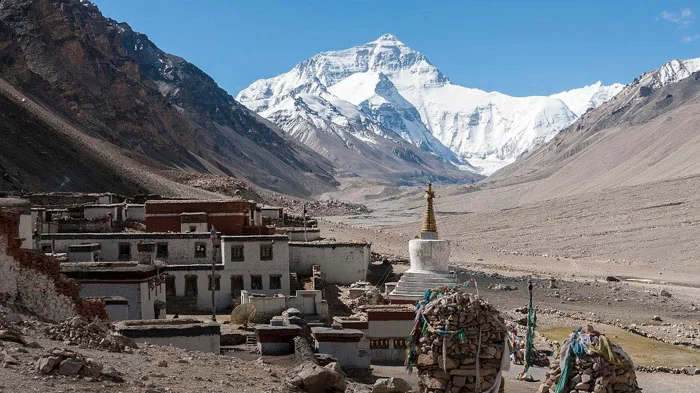
13. The Wifi & Tel Signal at Everest Base Camp of Tibet is Very Good in Nowadays
Uninterrupted network access is crucial, especially when you are touring the roof of the world. Nowadays, the wifi and mobile signal at Everest Base Camp of Tibet have improved in quality. Local Chinese SIM cards provide good coverage, even at Everest Base Camp. Travelers can buy one to fit in their unlocked phones or rent a pocket wifi unit at the airport upon arrival, allowing internet access during their Tibet trip.
However, Everest Base Camp accommodations, including Rongbuk Monastery and tented options, do not provide wifi, so renting a portable wifi device is advisable for connectivity if you don't have an unlocked phone.
14. You Can Never Take a Shower at Everest Base Camp; Also Need to Overcome the Toilet Problem
Running water is a luxury at a high altitude (5200m) due to water scarcity, so taking showers at Everest Base Camp in Tibet is a distant dream. Accommodations are very basic here, and they lack shower facilities. The only toilet in the tents is a pit toilet with questionable hygiene, and Rongbuk Monastery guesthouse bathroom quality is a little better, but the concrete pit toilet may be uncomfortable for Westerners.
15. There is a Post Office at Everest Base Camp, but Only Available from End of May to End of October
Surprise your pals with a souvenir to remember - postcards from the top of the world! The world's highest post office is located in Everest Base Camp in Tibet, China Post Office. Running since 2008, this tiny post office is operated by only three officials from 10:00 to 18:00. Due to harsh winters, the post office remains open only seasonally, from the end of May to the end of October.
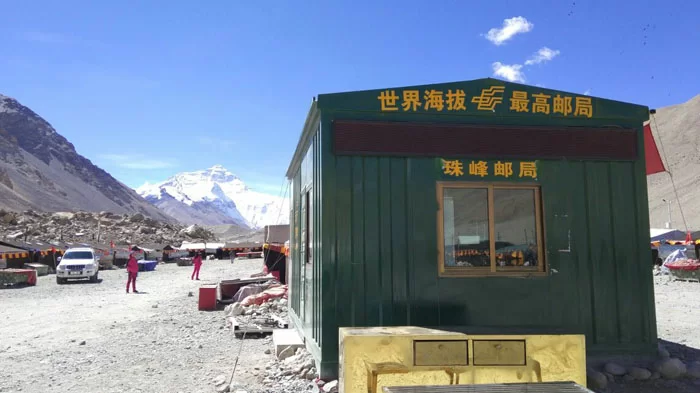
16. 8 Days Lhasa to Everest Base Camp Overland is the Most Recommended Itinerary
Our 8 days Lhasa to Everest Base Camp overland tour is a comprehensive journey plan that takes you through all the Tibetan highlights like prominent monasteries, pristine lakes, and the Himalayan Range to reach the base camp of Mt. Everest. The altitude ascension is gradual to keep the altitude sickness at bay. The tour begins with 2 days of altitude acclimatization in Lhasa with visits to the Potala Palace, Jokhang Temple, and Sera Monastery.
Travel to Shigatse via Gyantse to explore the Pelkor Monastery and Gyantse Kumbum. Continue to Everest Base Camp to witness the stunning views of the world's highest peak. The tour also offers extra bonuses like eco-friendly water bottles, a warm apron, and a telescope. The tour concludes with a return to Lhasa.
17. Book Your Everest Base Camp Tour With A Local Tour Company
Booking your Everest Base Camp tour with a local tour company offers advantages like in-depth knowledge, experienced guides, and support for the local economy. As the successive award-winning Everest Base Camp tour operator in Tibet , we, Tibet Vista, can tailor the itinerary to your preferences and handle altitude-related challenges more effectively. With established local connections, we provide a safer and more personalized experience, ensuring a memorable journey through the stunning landscapes of Tibet. Also, price-wise, you can avoid in-between markups and do more pocket-friendly tours.
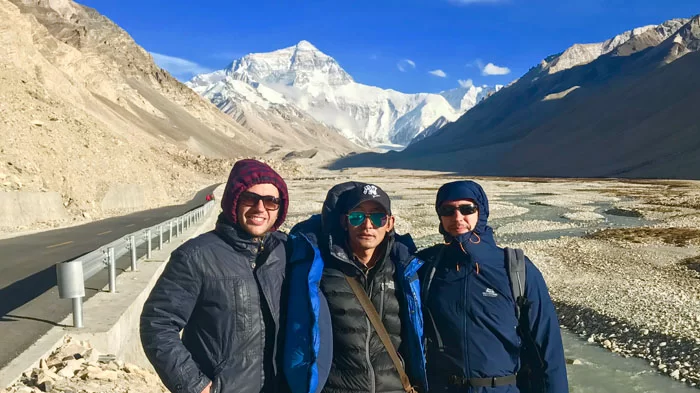
An Everest Base Camp tour in Tibet is a once-in-a-lifetime adventure, offering breathtaking views, rich cultural experiences, and the thrill of reaching the foothills of the world's highest peak. With our insider tips on Everest Base Camp in Tibet, however, we hope you know now what to expect on the tour and how to make the most of it . From preparing for high altitudes to capturing stunning sunrise and starry night views, these tips and tricks will make you feel you already know Everest Base Camp in Tibet and are well prepared to experience it with confidence and awe. Happy traveling!

About the Author - Master Kungga Dundruk
The Lhasa-born prodigy used to study business overseas, and got his Bachelor of Business in Nepal and India before moving back to his homeland. With pure passion for life and unlimited love for Tibet, Kunga started his guide career as early as 1997 .
Responsible, considerate, and humorous, he devoted his entire life to guiding and serving international tourists traveling in Tibet. As a legendary Tibetan travel guru with 20-year pro guide experience. Currently, he is working in Tibet Vista as the Tour Operating Director. Whenever our clients run into trouble, he is your first call and will offer prompt support.
https://plus.google.com/+Kunga-TibetVista
Read all my articles about Tibet travel
Related Articles & Posts
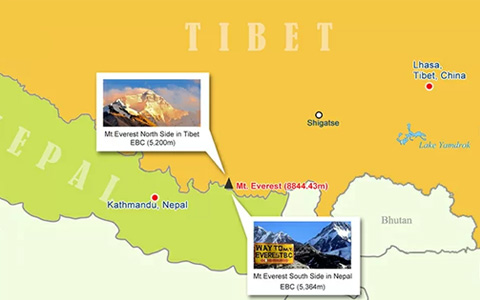
Since Nepal and Tibet, China jointly share Mt. Everest (8844.43m), there are two Everest Base Camps on both side of Hima ...
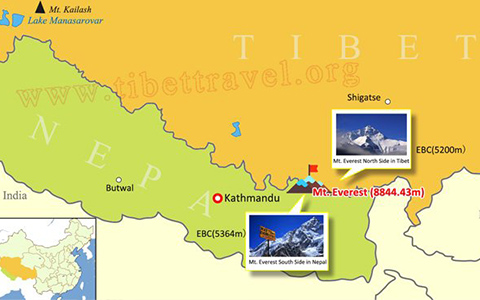
This page gives a detailed description on the tourist route maps about Mt. Everest tour on different levels and tips o ...
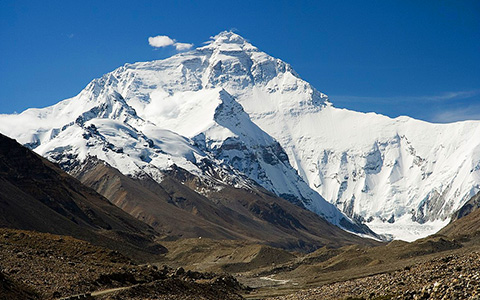
What is the best way to see Mount Everest? Different strokes for different folks. This article will introduce you the mo ...
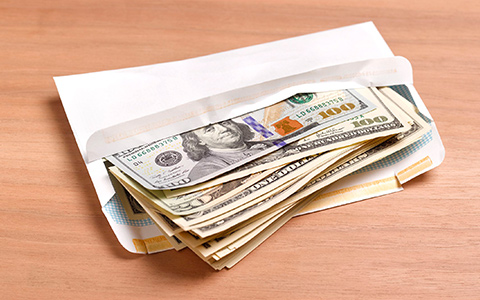
In this article, we offer you some general expense concerning the tour from Lhasa to EBC to help you predict the cost. ...
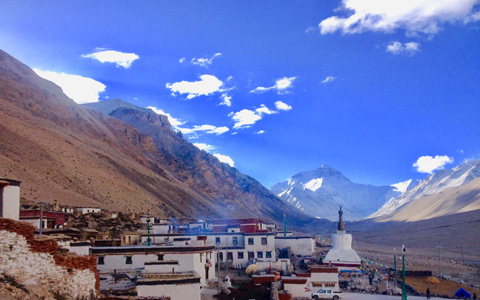
If you are going to visit Everest Base Camp to see the Mt. Everest, you should not miss this article about facts of Ever ...
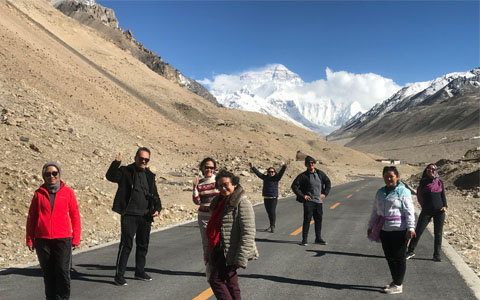
With an altitude of 5200m, Everest Base Camp is generally the highest place common travelers can go. And right because o ...
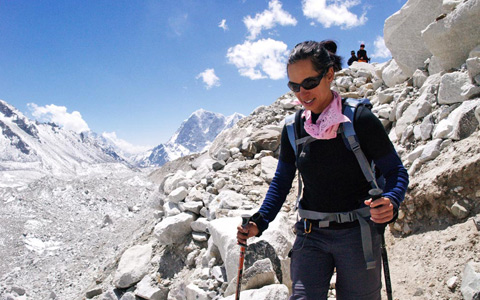
How to budget trekking cost is quite significant, even if Nepal is one of the cheapest counties to trek. And whether you ...
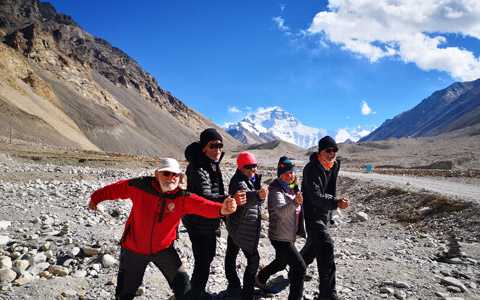
The best time to visit Everest Base Camp is generally in spring and autumn. Read this guide to know more about the clima ...
Most Popular Tour Packages

8 Days Lhasa to Everest Base Camp Small Group Tour: Marvel at Mt.Everest Real Close from 4 Different Viewing Platforms
Lhasa - Gyantse - Shigatse - Everest Base Camp - Shigatse - Lhasa

15 Days Kailash and Manasarova Small Group Tour: A pilgrim’s final fantasy and the greatest overland trip in Tibet.
Lhasa - Gyantse - Shigatse - E.B.C - Saga - Kailash Trek - Darchen - Lake Manasarovar - Saga - Gyirong - Tingri - Lhasa

10 Days Lhasa to Everest Base Camp and Namtso Lake Small Group Tour
Lhasa - Gyantse - Shigatse - EBC - Shigatse - Lhasa - Namtso Lake - Damxung - Lhasa

8 Days Driving Across Himalaya Overland Adventure from Kathmandu to Lhasa
Kathmandu - Gyirong - Everest Base Camp - Tingri - Shigatse - Gyantse - Lhasa

4 Days Lhasa Impression Small Group Tour: Explore the Heart of Tibet and Mingle with the Locals

7 Days Lhasa to Kathmandu Overland Small Group Tour: Traverse from the North Side to the South Side of Mt.Everest for the Best of the Himalayas
Lhasa - Gyantse - Shigatse - Everest Base Camp - Gyirong - Kathmandu

6 Days Central Tibet Culture Small Group Tour: Explore Tibet's religion, cultural gems, and captivating landscapes.
Lhasa - Gyantse - Shigatse- Lhasa

13 Day Lhasa, Mt. Everest, Mt. Kailash, Lake Manasarovar and Kathmandu Adventure Tour
Lhasa - Gyantse - Shigatse - EBC - Saga - Darchen - Kailash Trek - Darchen - Saga - Gyirong - Kathmandu
0 Comment ON "17 Things to Know Before Visiting the Everest Base Camp of Tibet "
Check All Tibet Travel FAQs Here

- Tips & Tricks
- Tales from the Trails

The Ultimate Insider’s Guide to Trekking Everest Base Camp
CAMPING TIPS & TRICKS , Hiking / Camping / Tour Companies , TRAVEL

At 8,848 meters, 29,029 feet above sea level, Mt. Everest is the tallest mountain in the world, towering over the surrounding peaks in the Himalayas mountain range on the border between Nepal and Tibet.

Even if you’re not a diehard mountaineer, you can still explore this beautiful region of Nepal with a trek to Everest base camp (EBC).
Not only will you get lifelong bragging rights for completing the trek to base camp, but it’s also a beautiful trek in its own right. Amazing vista can be seen passing through the Sagarmatha National Park and the awe-inspiring Himalayas .
Although the trek takes about two weeks, it’s surprisingly accessible and has been completed by many first-time trekkers.
Everest Base Camp: A Brief Overview
Since the first successful summit in 1953 by Sir Edmund Hillary and Sherpa Tenzing Norgay, the imposing peak has attracted decades of adrenaline-seekers wishing to add their name to the list of successful summiteers. A good portion of these climbers never returned .
Despite the intimidating statistics, the sister trek through the picturesque Khumbu Valley to the base camp used by professional mountaineers is an attainable goal for many people.

Located at an altitude of 5,361 meters, 17,590 feet above sea level, you don’t need fancy equipment or mountaineering skills to reach EBC. Certainly, it takes just a positive attitude and a reasonable level of fitness.
There’s a sense of camaraderie and a tangible buzz in the air as the adrenaline of the would-be Everest summiteers infects everybody around them.
The scenery at these altitudes is breathtaking and varied, ranging from rhododendrons and pine fields to rivers; suspension bridges strung with prayer flags; glaciers, lakes, valleys, high mountain passes, and finally, the spectacular Himalayan mountain peaks!
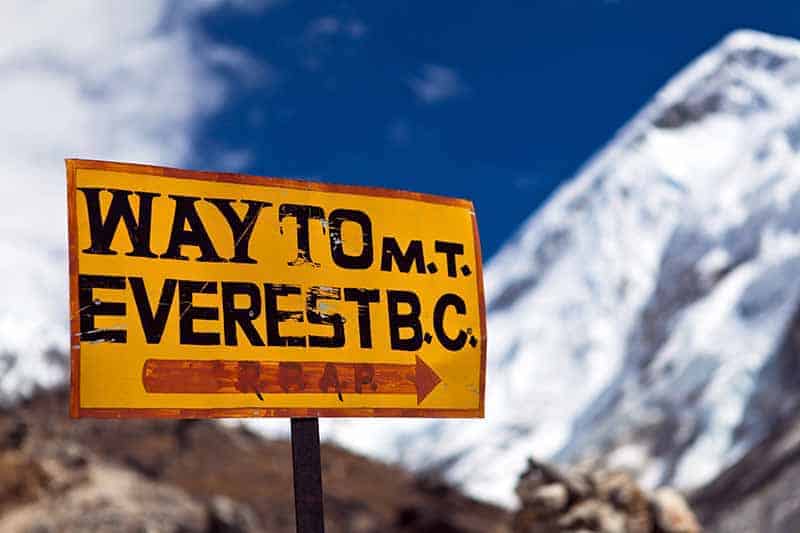
The Sagarmatha National Park is home to rare animal species such as snow leopards and red pandas – though it’s very unlikely you’ll encounter them. You’ll frequently have to step aside (to the uphill side!) as you encounter yaks on the trail.
Whether you choose to follow the traditional EBC route or one of the alternative trails, it’s guaranteed to be an experience you’ll never forget.
In contrast to most multi-day treks where you’d be camping in a tent, trekkers to base camp stay in cozy tea houses. You can find several available in a range of budgets, which function as both hotels and restaurants.
The trek is dotted with Buddhist monasteries and tiny villages almost all the way up. The relaxed pace of the trek allows plenty of time for you to explore the villages and get to know the local Sherpa culture.
Mt. Everest is increasingly covered in garbage left behind by the hordes of people who have set out to conquer its lofty heights. When you go, please respect the environment and do your best to minimize waste.
The most popular time of year to do the Everest base camp trek is between February and May – the pre-monsoon season.
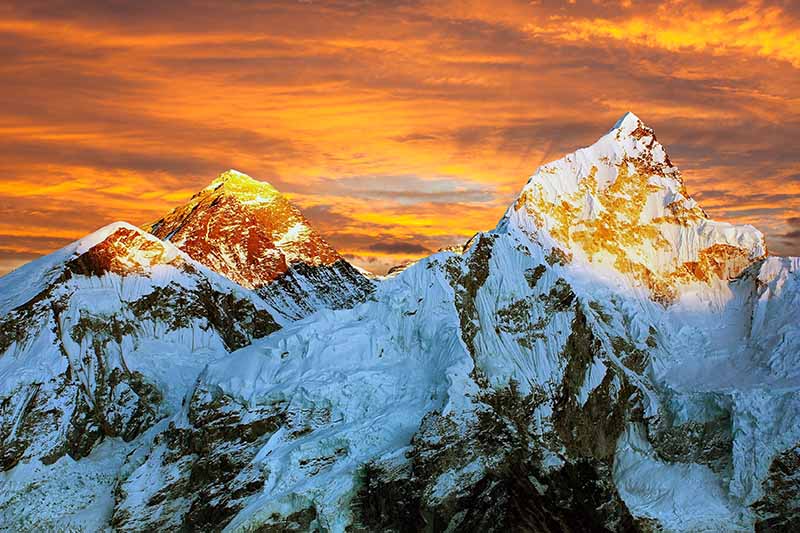
During these spring months, the weather is typically warm and dry and the mountains will be ablaze with colorful rhododendrons.
This is also peak season and while you’re unlikely to have the trails to yourself, you’ll enjoy a buzzing atmosphere at the tea houses on the way. This is also when most Everest climbers make their summit attempts.
The summer months bring the monsoon rains, resulting in slippery trails and a heightened risk of landslides. If that doesn’t deter you, the leeches and foggy weather might! It’s not recommended to attempt the trek in the summer.
It can also be difficult to fly into Lukla during the monsoon. Indeed, this is a good time to pick the Jiri trek over the classic EBC trek.

If you want fewer crowds, try going in September or October, the post-monsoon months, when you have the highest chance of clear skies, although temperatures are slightly colder.
You can even do the trek in the winter but be prepared for sub-zero temperatures most days and lots of snow.
Whenever you go, make sure you pack for unpredictable weather in case a snowstorm takes you by surprise.
Trekkers interested in the local culture might want to plan their trip dates around traditional holidays with celebrations in Kathmandu, such as Holi (February/March) or Indra Jatra (September).
Another thing to consider when planning your trip is flight prices, which can vary considerably. Check flights before booking as this might have a huge impact on when you want to go.
Lastly, be aware that it might be harder to find tour operators who provide treks in off-season months. Also, some of the paths might be closed.
Conversely, if you want a stab at actually sleeping in Everest Base Camp, then late spring is your best option. It will be rare to find tour operators who might be able to wrangle this.
Everest Base Camp Packing list
If this is your first multi-day trek, don’t forget to budget for all the equipment you’ll have to take with you.
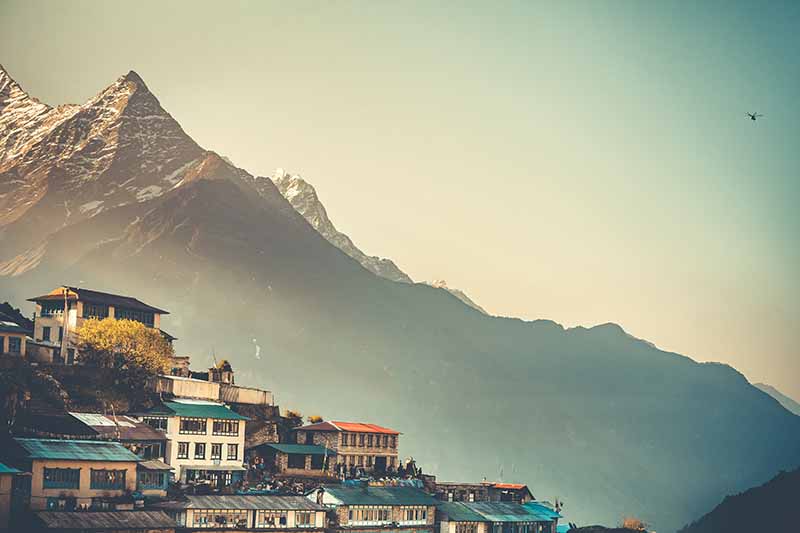
You can choose between renting or buying your gear. Hikers who plan on doing more multi-day treks might want to invest in their own equipment.
If you’re doing a two-week trek, it makes more sense to rent your sleeping bag and down jacket. For trekkers who plan on trekking for a whole month, it makes more financial sense to buy.
The neighborhood of Thamel in Kathmandu offers plenty of options for buying and renting. However, the products on offer may be of questionable quality.
Further on, Namche Bazaar is a last-resort option if you find you’ve forgotten to pack any essentials. If you keep your receipts, then talk it over with the shop when buying. Some shops will buy your gear back from you, at the end of your trek, for a reduced price.
Almost everything available for sale along the trek has been carried up the mountain, either by yaks or people. This means things get more expensive the higher you go.
Pack strategically. This means bringing the items you can’t live without while avoiding overloading your backpack. Whether you hire a porter or decide to go solo, somebody will be lugging your things up the mountain. Indeed, think twice before including unnecessary items like an extra book or five spare shirts!
Aim to pack around 10kg if you’re carrying everything yourself, and 20-25kg if you’re getting help from a porter. Don’t forget that your water adds extra weight. Try packing your bag with full water bottles, to get a more accurate idea of how much you can bring.
This list is aimed at trekkers who will be sleeping in tea houses every night. Be aware that if you don’t book early enough, the tea houses may be sold out in high season.
If you think you might end up having to camp, Then you’ll need more supplies not covered on this list, such as a winter insulated tent , sleeping pad , etc.
What to Wear
The clothes you pack will depend on which season you’re visiting in. Make sure you have enough clothing to keep warm, especially in the evenings.

Layers are crucial, as temperatures and weather conditions will change drastically between day and night and as you ascend and descend in altitude.
Tea houses often only heat the common areas, and then only in the evenings, so bring warm clothes for lounging around at night.
The higher you get, the less likely you are to have power in your tea house, or only for a few hours as they’re run off solar power.
Base layers: Your base layer should be comfortable and moisture-wicking. Stay away from cotton; go for merino wool or synthetics .
Pack a long-sleeved shirt (avoid short sleeves as you’re more likely to get sunburnt) and long underwear, if only for the cold evenings.
Fleece mid-layer: You’ll probably be putting this on and taking it off with every mountain pass. Indeed, try to find one that will fit easily into your day pack.
Outer layer: Get a down jacket with a good warmth-to-weight ratio, as you’ll be carrying it much of the time.
Waterproof windbreaker and pants.
Hiking pants: Well-insulated trekking pants , or trekking pants that can turn into shorts.
Waterproof hiking boots. We can’t stress enough how important it is to break your hiking boots in properly before your trek.
Don’t forget to bring a pair of comfortable sneakers or sandals for the evenings and for bathroom runs.
Socks: Woollen hiking socks are worth the investment – bring a few pairs that can handle very cold temperatures for the higher altitudes, and look for flat seams and padded spots to reduce blisters.
Sock liners and Vaseline are two other good ways to prevent blisters . You should also bring a pair of warm socks for base camp.
Gaiters: These will be especially useful during the rainier months.
Gloves : Pack a thin pair of “inner” gloves and a very warm pair of outer gloves. There will be at least one or two days where your fingers will freeze otherwise – for example, the day you summit Kala Patthar.
Scarf/balaclava/buff: The trail to EBC gets infamously dusty, provoking the “ Khumbu cough ” that plagues many hikers. A buff or something similar will keep you warm as well as provide you with a layer to breathe through to minimize the amount of dust in your lungs.
Beanie and sun hat , preferably with neck cover, to protect against the sun .
Underwear and sports bras: You’ll probably be reusing these, so get good-quality, non-cotton ones.
Accessories
Drinking water: Most tour operators provide purified water. Avoid bottled water, as this is expensive on top of being an environmental disaster.

We recommend bringing two big reusable water bottles (or a water bladder for drinking on the go). Tablets take a while to work and it’s nice to have one water bottle ready to drink while the other one is getting purified.
You can also fill a bottle with hot water and sleep with it in your sleeping bag if you’re cold during the night. If you’re purifying your own water, bring water purification tablets , LifeStraw , or a Steri-pen. But remember, these need charging, and charging on the trail costs money.
You may wish to add flavor enhancers to your water. Unfortunately, at Gorak Shep the water is very mineralized so you’ll need to buy bottled water.
Showering: Whether or not you shower is up to you. Expect to pay around $5 for a hot shower. Some people rely on wet or backpacking body wipes , especially since wet hair is no fun in negative temperatures!
Sunglasses: The combination of snow and altitude is brutal on your eyes, so invest in good polarized sunglasses with wraparound arms.
Sleeping bag : The teahouses will provide blankets and pillows but you’ll want your own sleeping bag and pillowcase.
Find a mummy sleeping bag rated to -20° C – or colder, depending on the season. Consider bringing a silk liner , especially if you’re renting your sleeping bag.
Toiletries: Sunscreen , SPF chapstick (this is better than lip balm as there’s no need to smear it on with your grubby fingers), quick-drying towel, tissue, baby wipes, period supplies, compressed toilet paper tablets or biodegradable toilet paper (remove cardboard and keep in ziptop bag), hand sanitizer, toothbrush and toothpaste, etc.
Always bring toilet paper with you. Most bathrooms are squat toilets and are located only in villages.
Tip : wet wipes are more expensive than toilet paper on the trail, so if you have to choose, stock up on wet wipes and buy toilet paper when you run out.
Shewee: Ladies, you’ll be glad not to have to pull your pants down in the freezing high-altitude weather. If you need to pee, then I recommend using a portable pee device, like PeeBuddy Reusable Female Urination Device . You stand and use the portable pee funnel, so you don’t need to squat.
If you get your period on the trail and you’re not comfortable with using the DivaCup, another good option is to keep used pads/tampons in a ziptop bag and dispose of them in the next garbage can.
Personal first-aid kit: Bring diarrhea meds, altitude meds, antibiotics, ibuprofen, paracetamol, aspirin, bandaids, blister plasters, tape/trekker’s wool, Vaseline, cough drops (to beat the Khumbu cough), cold medicine, rehydration salts.
Tour operators should provide the rest. Don’t forget to get your travel vaccines before you go.
TSA approved padlock for your luggage.
Backpack: What you pack your gear in will depend on whether you’re using porters. Most porters prefer you to pack your things in a soft-sided duffel bag. Check with the tour operator in case they provide these for you.
If you have a porter, then you’ll only need a daypack for yourself. If you’re not hiring a porter, then bring a collapsible daypack anyway in addition to your backpack. This is so you can leave your big backpack in the tea house during the one-day acclimatization hikes.

Try to get a backpack with straps for hiking poles and zippers to open it from the sides. Not to mention, you won’t have to dig everything out of your bag whenever you want to access something.
Dry bag or plastic cover for your backpack and daypack to prevent water ingress.
Hiking poles : These are a must! All the treks listed here will take you uphill, downhill, uphill and downhill again. Hiking poles will save your knees, and they’ll come in handy on slippery trails during the wet season.
Headlamp or flashlight : You’ll be glad to have this in the evenings after the power goes out, and during early-morning or late-night hikes. Remember to bring extra batteries.
Trekking map: If you’re going independently, a good trekking guidebook is essential – Lonely Planet is highly recommended.
Ziptop bags: These always come in handy for protecting electronics, etc.
Camera or GoPro with memory card and extra batteries.
Money: There are ATMs at select points such as Lukla and Namche Bazaar. But these have low daily withdrawal limits and high commission fees. What’s more, they have been known to take money out of your account without actually dispensing it to you.
Since currency exchange rates on the trail are sky-high, it’s best to bring a stash of local rupees with you. You’ll need rupees to pay for meals, showers, tips, etc.
Wi-Fi: A good option for staying connected is to buy a local sim card. It will give you data to about 4000m altitudes, and sometimes in EBC itself.
You can also check Everest Link for Wi-Fi data packages. The connection is supposedly available in most teahouses along the way, but it can be slow and unreliable so don’t depend on it too much.
Top Tip : Beware of phone updates. These will eat through your Wi-Fi and data limits before you realize what just happened!

Entertainment: EBC treks usually only schedule a few hours of hiking a day, to allow you time to acclimatize. Bring books, a Kindle , cards or other games for the many hours of downtime. Certainly, bring a journal so you can remember this once-in-a-lifetime experience!
Solar charger: Many teahouses offer power points where you can charge your devices for a nominal fee. Also, don’t forget to bring an adapter. It’s a good idea to bring your own solar-powered charger and extra batteries to minimize costs.
Tip : Keep batteries, base layers , and anything else you don’t want freezing in your sleeping bag with you overnight. Keep your phone in flight mode to save power.
Important documents: Bring printouts of your travel insurance information. And make sure one of your travel buddies knows what to do and whom to contact in case of an emergency.
Bring your passport, visas, money, etc. – I always keep these documents in a zip-top bag.
Trekking solo? Bring a safety whistle , compass , pocket knife , & duct tape, especially on the less-crowded trails
High-calorie snacks: These will make a huge difference to your experience. Snacks are exceedingly expensive on the trail, and they provide welcome calories on tough trekking days.
You’ll have to decide how many you want to bring and which ones you want to buy along the trail.
Cloth bags : Many trekkers use these to separate dirty laundry and organize different outfits.
Earplugs: You’ll be glad for these when the tea houses are alive with the sound of Khumbu coughs.
A Note on Trekking Insurance
Be very careful when purchasing travel insurance, because regular policies usually stop covering you once you ascend higher than 3,000m/9,840ft.

At these altitudes, you have a higher chance of getting Acute Mountain Sickness. Also, there’s a pretty good chance you’ll have to be airlifted out to a hospital for injuries . To clarify, injuries like a pulled muscle or twisted ankle at sea level can be more serious at higher altitudes.
Because of these higher costs and risks , insurance companies will charge you a premium for high-altitude trekking insurance.
Luckily, there’s no shortage of insurance companies that offer travel insurance specifically tailored to Everest Base Camp trekkers.
When purchasing a policy, make sure you’re covered for trekking up to altitudes of 6,000m/19,685ft. In addition, ensure it has search and rescue costs, preferably by helicopter.
Don’t forget to check if you’re covered for different travel-related illnesses (and make sure you get your vaccinations before going!).
It’s also nice to have compensation for delayed or canceled flights and repatriation in case of death (hopefully you won’t be needing this one).
Check the clause about lost, stolen or damaged luggage to see if it will cover most of the cost of your hiking gear.

If you’re traveling in winter or shoulder season, then check for trip cancelation insurance. This is to ensure you’re covered if your trek is canceled due to weather.
You’ll likely have other considerations depending on your personal situation. Don’t just take our advice for it – remember to do your research, ask questions and read the fine print of your travel insurance policy before you purchase.
I always keep my travel insurance information handy while on the trek. Additionally, I pass it along to someone else in my group. This is so they know whom to contact in case of an emergency.
Some travel insurance providers require you to confirm with them before ordering a helicopter. Check out this option on getting trekking travel insurance for more information.
How to Avoid Altitude Sickness
Most tour operators organize a relaxed trekking schedule and follow the mantra “climb high, sleep low”. In essence, this is to avoid the risk of altitude sickness.
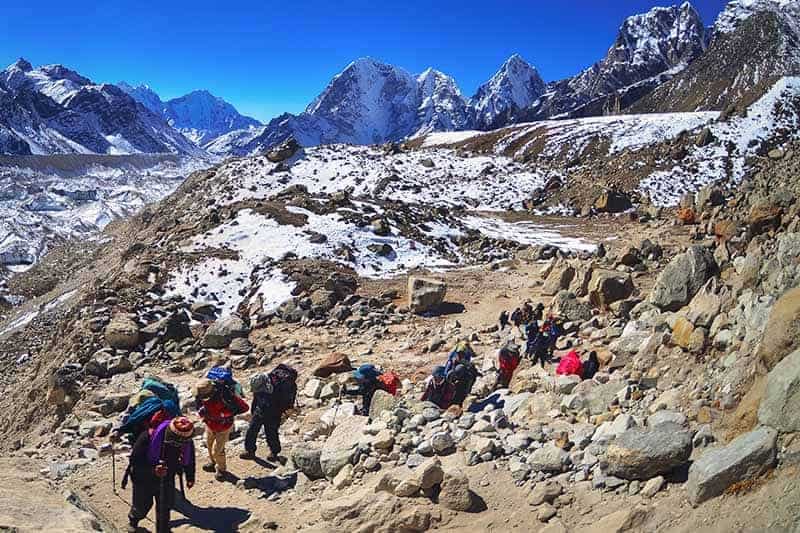
Take it slow – once you finish hiking for the day you’ll have a lot of dead hours in the teahouse. For this reason there’s really no point in racing there.
It’s important to respect the acclimatization days. The acclimatization hikes are designed to help you adjust to tomorrow’s altitude.
Try to drink 3-4 liters of water a day, as dehydration will make the altitude sickness way worse. It also goes without saying that you shouldn’t drink caffeine or alcohol or smoke during your trek.
If you can, then cut out these vices about a week before you start hiking. So that you won’t suffer from withdrawal headaches.
Many people swear by Diamox as a preventative drug against AMS. It’s your choice whether to take this or not. I personally found the tingling fingers and toes to be very off-putting, but it probably helped me acclimatize.
Altitude sickness is unpredictable and doesn’t discriminate based on fitness or age. Listen to your body and descend immediately if you think you have signs of Acute Mountain Sickness.
Check out our article on altitude sickness for a more detailed overview.
Choosing a Tour Operator
Every year there are rumors that the Nepali government will make it compulsory to go with a guide.. But so far, it’s still possible to undertake the trek to EBC on your own.

Unless you’re going in high season, you’ll can drop in at tea houses and get a bed without a reservation.
Independent trekkers can choose whether to hike all by themselves. While others choose between ring a porter, a guide, or a guide and a porter. A guide will speak some English and can help with booking accommodation. However, a porter probably won’t speak English and will only carry your bag.
You can also hire one person who acts as a guide and a porter. Another upside to hiring a guide is that you’ll be providing someone with a job. And in turn, you’ll get to immerse yourself in the Nepali culture.
Alternately, you can opt to join a guided trek with a tour operator. While this is pricier, it’s a good choice for people who have never done such a long, high-altitude trek before.
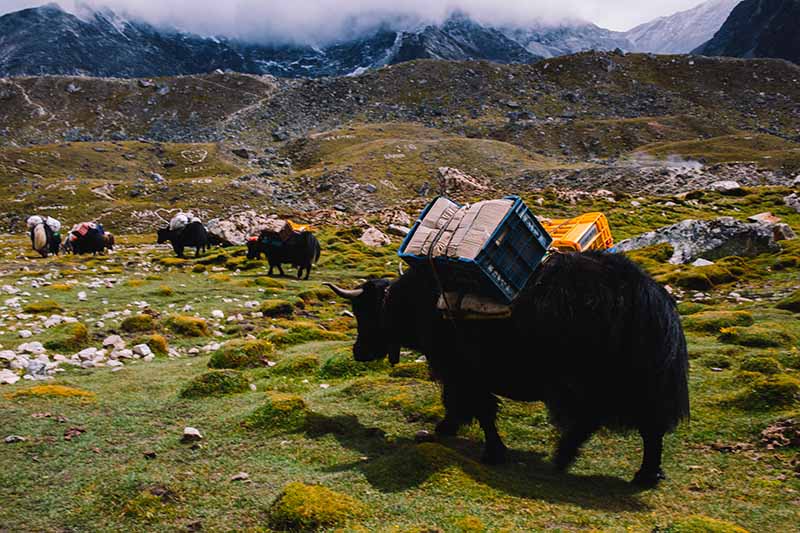
Tour operators typically arrange flights, airport transfers, accommodation, visas and permits, porters and guides. Western tour operators will usually charge more, but provide a more trustworthy service. You can expect to pay about twice as much for a Western tour operator.
Check to see if your tour operator is registered with the Trekking Agencies Association of Nepal (TAAN). TAAN regulates trekking agencies in Nepal to ensure fair treatment of employees, respect for local communities and preservation of the environment.
The Kilimanjaro Porters Assistance Project mission is to improve the working conditions of porters. They advocate for fair treatment and wages, lend free mountaineering clothing, and encourage them to work for only ethical companies. Through providing education and training opportunities, guides and porters have received classes on porters rights, Leave No Trace and are certified in First Aid.
Please make every effort to ensure the porters and guides are dressed properly, stay within the weight limit including their own luggage. Also, ensure they have adequate sleeping arrangements and insurance and are paid a fair wage.
It’s better to go with companies that employ their porters and guides full-time instead of freelance because there’s a better chance the company is providing them with benefits, sick days and health insurance.
Tipping is always a tricky subject and suggested rates will depend on whom you ask. Aim for around 15 percent of salary (if you’re traveling in a group, this number refers to the total pooled tip) per porter and/or guide, and adjust accordingly.
The classic Everest Base Camp trek winds through the Khumbu valley; once reaching Everest Base Camp, you’ll retrace your steps back down to Lukla for the return flight to Kathmandu.

If you’re interested in escaping the crowds or doing circular routes that don’t involve retracing your steps, there’s a variety of alternate routes to choose from.
You can also opt to tack small detours onto your classic EBC trek. This is especially doable if you’re traveling independently or in a small group.
You shouldn’t have any trouble booking your trek, even on the classic EBC trek.
Classic Everest Base Camp trek
The classic Everest Base Camp trek takes about 14 days, including time in Kathmandu before and after.
From Kathmandu, you’ll fly into Lukla Airport (2,860m/9,383ft) with its famously short runway – try to sit on the left side of the plane so you can catch your first views of Mt. Everest.
It’s a good idea to leave yourself a few buffer days, as Lukla flights are often delayed due to weather. Flights should be included in your tour price; otherwise they’re about USD 300, plus USD 100 for your guide’s ticket.
From the airport, you’ll trek to Phakding for the night.
The next day you’ll set out from Phakding and follow the Dudh Koshi River, crossing suspension bridges and pine forests until you reach the Namche Bazaar (3,440m/11,286ft), in the Sagarmatha National Park UNESCO World Heritage Site .
Namche Bazaar is the region’s principal trading point, so use this opportunity to stock up on supplies you might have forgotten. If you’re there on Saturday, then don’t miss the market. From here you can also catch a peak of Everest.
You’ll take a day to acclimatize in Namche Bazaar – you can make the most of the Wi-Fi, stock up on any supplies you forgot, check out the Sherpa museum or just tool around the village.
The day after you’ll follow the former Tibet-Nepal trading route via Thame to Tengboche. These villages are known for legendary views, where you can visit one of the region’s biggest monasteries .
Next you’ll hike through Phangboche to Pheriche while admiring the views of Ama Dablam. You might be interested to know that Pheriche is where the Himalayan Rescue Association makes its base – but hopefully you won’t need to use this information!
Most people stay in Pheriche for a day to acclimatize and visit local attractions like the Imja Lake or Dingboche village, which boasts views of Lhotse and Island Peak.
Now that you’re rested, you’ll be ready to tackle the trek to Lobuche, which features a 600m/1,969ft elevation gain. You’ll skirt the perilous Khumbu Glacier and witness the many memorials to sherpas and climbers who perished in their attempt to climb Everest.
From Lobuche you’ll set out towards Gorak Shep, which is the world’s highest permanently inhabited village.
Finally, it’s time to push on through the moraine towards Everest Base Camp! Since actual summiteers of Everest have priority, don’t expect to spend too long there or even be allowed inside the base camp itself.
But don’t worry, the adrenaline-filled atmosphere extends all the way down to the trekker stop point! From here you’ll go back down to Gorak Shep for the night.
You can’t actually see the peak of Mt. Everest from Everest Base Camp, so the next day you’ll make a steep ascent up to the summit of Kala Patthar (5545m/ 18,192ft) to catch amazing views of Everest, Nuptse (7,861m/25,791ft) and Lhotse (8,516m/27,940ft).
Most groups try to do this at sunset on the same day as they reach EBC, or at sunrise the next morning, when Mt. Everest sometimes turns pink in the early-morning light.
Forging on ahead, you’ll descend to Dingboche or Pheriche, and from there past Tengboche and back to Namche Bazaar the next day. Keep an eye out for the massive fields of wild rhododendrons if you’re visiting in the spring!
Your last day of trekking will take you back to Lukla, where you’ll spend the night before catching the flight to Kathmandu.
- Pros : Comparatively gentle altitude profile, can be done independently
- Cons : Have to retrace steps on the way down, can be crowded
- Length : ~130km (12-14 days)
- Highest point : Kala Patthar (5545m/ 18,192ft)
Gokyo Lakes Trek
The Gokyo Lakes Trek is popular for its beautiful glacial lakes , nestled in the quiet Gokyo valley.
Like the classic Everest Base Camp trek, the Gokyo Lakes trek starts at Lukla, breaking off towards the northwest at the Namche Bazaar.
This trek is considered slightly more challenging than the classic EBC trek, with steeper ascents and more time spent at high altitudes.
It takes 2-3 days longer, detouring around some of the most crowded sections of the classic base camp trek but still finishing at Everest Base Camp.
You’ll see glacial lakes and summit Gokyo Ri (5,357m/17,575ft) where you’ll earn views of Everest, Lhotse and Cho Oyu (8,201m/26,906ft).
Fly into Kathmandu, spend a few days acclimatizing and then take another flight to Lukla. The next day, you’ll trek down through the Dudh Koshi Valley to Phakding past several Buddhist sites.
Hiking through pine forests and along the Dudh Koshi River, you’ll cross several suspension bridges including the Hillary Suspension Bridge. After entering the Sagarmatha National Park, you’ll continue hiking until the Namche Bazaar.
You’ll then separate from the classic EBC trek and head northwest towards Dole along the Dudh Koshi valley. You’ll get some of the first views of Everest, Lhotse and Ama Dablam today.
The next day brings a steep climb towards Machhermo, which is populated with yaks in the summer.
Allow yourself a day to acclimatize and enjoy views of Ngozumpa Glacier (the biggest glacier in the Himalayas). Once you’ve enjoyed the glacier, trek to the Gokyo lakes and you’ll eventually reach Gokyo village. If you are tired by now, you’re in luck because this is where you’ll bed down for the night.
This is another popular time to take an acclimatization rest day and explore the surrounding lakes, or summit Gokyo Ri, which stands almost 5,500m/18,045ft above sea level.
Stop to take in the stunning views of Everest, Lhotse and Cho Oyu, then continue back down to the Ngozumpa glacier and on into Dragnag.
The next day is a tough one. You’ll traverse Cho La, one of the “Three Passes” (5,420m/17,782ft), cross a glacier and then spend the night in Zonglha.
Joining up with the classic EBC trek, you’ll stop for a moment of reflection at the memorials to sherpas and climbers who perished in their attempts to climb Everest, and then continue on to Lobuche for the night.
From Lobuche, you’ll skirt the Khumbu glacier, hiking up past Gorak Shep and finally you’ll reach Everest Base Camp! Enjoy it while it lasts, because the priority at EBC is the Everest summiteers, especially in the spring months.
You’ll hike back down to Gorak Shep alongside views of the Khumbu icefall . Part of the highest glacier on Earth, the icefall’s deadly crevasses, unstable seracs and unpredictable avalanches have taken dozens of lives.
The next day you’ll hike up Kala Patthar, with more views of Everest and the neighboring mountain peaks, and then down to Dingboche along the classic EBC route.
It’s time to return to Namche Bazaar. The day after you’ll hike back to Lukla through the Dudh Koshi valley, and then fly into Kathmandu.
Because the trek is longer, expect to pay more than you would for the classic EBC trek. Trekkers are advised not to attempt this trek independently, due to the increased difficulty and the fact that there are fewer people on the routes.
Like the classic EBC trek, the best time to go is during spring or fall. Because the trek isn’t as popular, you shouldn’t have to worry about crowds for most of the way, so feel free to go during peak season.
- Pros : Fewer crowds, more challenging, more sights, get to summit a peak, see the world’s highest freshwater lake system, prettier landscapes than classic trek, circular route so no need to retrace steps
- Cons : More expensive than classic EBC trek
- Length : ~220km/136 miles (16-17 days, including a few days in Kathmandu before and after)
- Highest point : Kala Patthar (5545m/18,192ft)
Jiri to Everest Base Camp
This old-school route mirrors the route taken by the first Everest summiteers in the 1950’s, starting with an 8-hour bus ride from Kathmandu to Jiri instead of flying into Lukla.
From Jiri, you’ll pass through the towns of Sete, Junbesi and Numtala in the Solu Khumbu region.
After reaching Lukla, you’ll join up with the classic EBC trek, passing through Phakding, Namche Bazaar, Tengboche, Pheriche and Gorak Shep.
In total, the Jiri route takes about 5-6 days longer than the classic route.
Jiri route trekkers will have the chance to spend a lot more time with the locals. You’ll also spend more time at low altitudes – the route starts at just 1,800m/5,905ft above sea level – meaning landscapes will forests and streams with actual running water.
Much of the trek is off the beaten path, with fewer crowds than the EBC classic trek.
Tool around Kathmandu for a day and then take an 8-hour (190km/118 mile) bus ride, following the Sun Koshi River to Jiri and then Shivalaya.
The next day, you’ll cross a suspension bridge over the river and then explore several tea houses. Go through the Deorali Pass, taking a moment to check out the prayer flags and decorated walls, and then head down to Bhandar for the night.
From Bhandar, you’ll walk through fields and forests before embarking on a steep descent t
owards the village of Kenja. Uphill again, you’ll traverse the Lamjura Pass and arrive at the town of Sete.
The next day, you’ll return to the Lamjura Pass and pass through magnificent fields of pine trees, magnolia and rhododendrons. Without a doubt, you’ll appreciate the stunning mountain views. Next,hike down the other side and you’ll arrive at the town of Junbesi.
Back into the forest, you’ll see Mt. Everest for the first time. You’ll then cross the Ringmo Khola suspension bridge and arrive at the village of Ringmo with its gorgeous Tibetan architecture. Another forest and you’ll be at Nunthala.
In the morning, you’ll head out towards the Dudh Koshi River, crossing another impressive suspension bridge on your way to Bupsa.
The next few days will take you to higher altitudes as you pass through forests with monkeys and several small villages.
Arriving in Lukla, you’ll join up with the classic EBC trek. After reaching Everest Base Camp, you’ll summit Kala Patthar for the obligatory views of Mt. Everest at dawn and then return through Gorak Shep, Namche Bazaar and finally Lukla, for your flight back to Kathmandu.
Like the classic Everest trek, the Jiri route is best undertaken in spring or fall. Caution: some parts of the Jiri trek may be closed in the winter, so we don’t recommend going during this season.
The Jiri route is only slightly more difficult than the classic Everest Base Camp route, due to its longer duration.
The average day of hiking comprises 5-6 hours, covering about 15km/9 miles. On the bright side, due to the more gradual ascent compared with the classic trek, you’re less likely to get altitude sickness.
- Pros : More authentic, less touristy, chance to see Solo Khumbu landscapes (terraced farmland, forests, Dudh Koshi river, sherpas), gradual acclimatization
- Cons : 8-hour bus ride (but scenic!)
- Length : ~250km/155 miles (22 days, of which 18 days of trekking)
- Highest point : Kala Patthar (5,545m/ 18,192ft)
Three Passes Trek
As you might infer from the name, the Three Passes trek takes you across three high mountain passes (all higher than 5,000m/16,400ft). Thus, making it more difficult than the classic EBC trek.
After reaching Namche Bazaar, the Three Passes trek splits off from the classic trek. This takes you towards Thame and the Nangpa Valley. The trek takes around 19 days in total, of which 14-15 will be spent trekking. Getting a guide is highly recommended.
After flying into Lukla from Kathmandu, you’ll work your way down to Phakding.
The next day will take you across several suspension bridges on the way to Namche Bazaar. You’ll be there for a day of acclimatizing. After which you’ll split off from the classic EBC route and head to Thame.
Crossing the Bhote Koshi river, you’ll reach Lumde and catch your first good views of the mountain peaks. The next day, you’ll tackle the first pass.
The Renjo La (5,360m/17,585ft) lies near the Dudh Koshi valley and will reward you with views of Everest. Then you’ll pass the Gokyo lakes and the village of Gokyo, where you’ll summit Gokyo Ri and catch sight of Cho Oyu.
After spending some time acclimatizing in Gokyo, you’ll walk across the Ngozumpa Glacier. This is Nepal’s largest glacier, and you’ll then spend the night in Dragnag.
The next day is notorious. You’ll traverse the next pass, Cho La (5,420m/17,782 ft), which has a glacier and prayer flags at the top. On the other side of the pass lies Zonglha.
Joining back up with the base camp trek, you’ll visit Lobuche and Gorak Shep and take in views of the Khumbu Glacier, Everest, Lhotse and Nuptse.
You’ll explore Everest Base Camp and summit Kala Patthar before retracing your steps back through Gorak Shep and Lobuche.
The trek keeps on going, past the Kongma La pass (5,535m/18,159ft), down into the Chukkung valley and up to the summit of Chukking Ri (5,550m/18,209ft) with more mountain views.
You’ll trek through Dingboche, with its views over the Khumbu Valley. Eventually, you hike down through the rhododendron fields and the village of Khumjung, ending back at the Namche Bazaar.
From here you’ll cross the Dudh Koshi, following the classic EBC route back down to Lukla.
This trek can also be done backwards; it’s up to you whether you want to head clockwise or counter-clockwise after the Namche Bazaar.
Many people recommend doing the trek counter-clockwise to avoid crossing the difficult Renjo La Pass right off the bat.
You’re best off doing this trek with a tour operator, as it’s quite off the beaten path.
- Pros : See a little bit of everything, uncrowded trails, challenging elevation profile
- Cons : Riskier terrain than classic EBC trail, long stretches with no facilities
- Length : ~21 days (150km/90 miles)
- Highest point : Chukking Ri (5,550m/18,209ft)

Island Peak (Imja Tse)
Experienced trekkers who wish to try their hand at mountaineering might be interested in summiting Island Peak (6,189 m/20,305 ft).

To master the glaciers and icy headwall during the ascent of these peaks, you’ll need to use crampons, an ice ax and potentially a ladder and ropes to cross the crevasses, depending on the weather.
Tour operators claim you can learn these skills on the fly, but it’s better to have some prior mountaineering experience before you tackle these routes, which are significantly more challenging.
That being said, Island Peak is a relatively “easy” climb as far as climbs go, so it’s a good option if you’re looking to expand your repertoire.
Since a detailed itinerary of Island Peak is outside the scope of this article, be aware that the general packing list doesn’t include the specialized mountaineering equipment you need for this trek.
Likewise, ascending Island Peak takes you above 6,000m and will probably not be covered by standard travel insurance providers, so check with your local mountaineering association for options.
Practical Information
What will I eat? How much will the trip cost? These are the questions most frequently asked.
As a general rule, the tea house lodgings themselves are very, very cheap with the condition that you eat dinner and breakfast in the same lodge.
This is where your costs will really add up – food is very expensive – so check with your tour operator when booking to see if meals are included.
Food on the trek is repetitive but nourishing. The meals are carb-heavy – think pasta dishes, dahl baht or “sherpa stew” with veggies and noodles.
What other trek offers the convenience of stopping in at a tea house or bakery for a hot lunch or freshly baked pastry? Just be prepared for stretches where you won’t see a tea house for several hours.
Hot drinks are readily available, and a popular treat is a deep-fried Mars bar. Don’t leave without trying one!
Most people recommend going vegetarian during the trek. Sagarmatha National Park has a no-kill policy so all meat has to be carried up by porters or yaks and is never very fresh, so there’s a real risk of getting sick.
Much of the garbage that’s disposed of in the villages ends up getting burned on-site, which really makes you consider the impact of your waste.
Before wantonly throwing plastic into the garbage cans, try to reduce what you use and pack out as much as you can.
The budget for your trip will vary widely depending on whether you’re trekking independently or going with a tour operator.
If you are booking with a tour operator, the flight price and permit prices should be included – usually you’ll have to pay for your guide’s flight as well.
Tour prices run from about USD 1000 to 3000 depending whether you go local or get a Western tour operator.
Budget around USD 400 for the flight from Kathmandu to Lukla Airport, including your guide’s ticket. If you go independently, consider getting help from a local agency for buying your flight tickets.
Flights have a way of being overbooked and you’re more likely to get on the plane if a local agent is vouching for you. On this note, factor in a few buffer days for your flight from Lukla back to Kathmandu, in case of weather or overbooking delays.
Nationals of all countries except India will need a visa to enter Nepal, which costs USD 25 for 15 days, USD 40 for 30 days and USD 100 for 90 days.
You’re best off getting the 30-day visa even if your trek is only scheduled to take two weeks, as weather and other factors might extend the trip unexpectedly. For the most part, you can get your visa when you land in Nepal.
It used to be mandatory to purchase a Trekkers Information Management System (TIMS) card, but the laws on this are constantly changing and there is a new local tax being charged, so check before you go unless your tour operator is arranging paperwork for you.
You will need a Sagarmatha National Park entry permit, which you can get ahead of time or at Monjo, when entering the park.
The price of the permits will normally be included in the trip price if going with a tour operator. Bring several passport photos for the permits.
All Set: Are You Ready?
The name “Everest” may sound intimidating, but this is actually one of the more approachable multi-day treks out there.

If you have a reasonable fitness level and are comfortable walking uphill for several hours a day carrying a heavy backpack, then you should be able to complete the trek. The key is to go slowly to avoid altitude sickness.
You don’t need special mountaineering know-how or an incredible level of fitness. The hike to EBC is a relaxed one, as hikes go.
The pace is slow, to allow you the time to acclimatize, so you’ll have plenty of free hours to peruse the village cafés, tuck into a slice of apple pie and snuggle up with a good book or make friends over a game of cards back at the teahouse.
That being said, of course it’s a good idea to prepare for the trek by hitting the gym in the months prior to your departure, and plenty of practice hikes starting two months before you go.
Don’t forget to practice hiking with a heavy backpack on! Check out this article for more tips on preparing for an uphill hike .
In total, the trek is around 130km/81 miles round trip, with an elevation gain of 2,685m/8,809ft between Lukla (2,860 m) and Kala Patthar (5,545 m).
It’s usually done in just under two weeks, including rest days for acclimatization. The outward leg will take longer and you can expect to trek 5-6 hours per trekking day, covering an average of 15km/9 miles.
The hike from EBC back to Lukla will go much faster since you’ll already be acclimatized.
Plenty of people with no prior trekking experience manage to complete the EBC trek and you can too! Like any non-technical trek at altitude , the key is a proper pace, a decent level of fitness and most of all, a good attitude!
Have you been trekking in Nepal? Let us know about it in the comments section below!
Disclaimer : This post is for information only and is not intended to replace the advice of an experienced guide. Always do your research and check with local weather stations, etc. before attempting to undertake treks in the wild. Distances are approximate and routes may vary depending on your tour operator.
Photos via Depositphotos.
- Insider’s Guide to Hiking Machu Picchu
- Inspirational Mountains: Exciting Summits for Ordinary Hikers
- Climbing Kilimanjaro: Everything you Need to Know
- Four Pass Loop (This Hiking Trail Should Be at the Top of Your List)
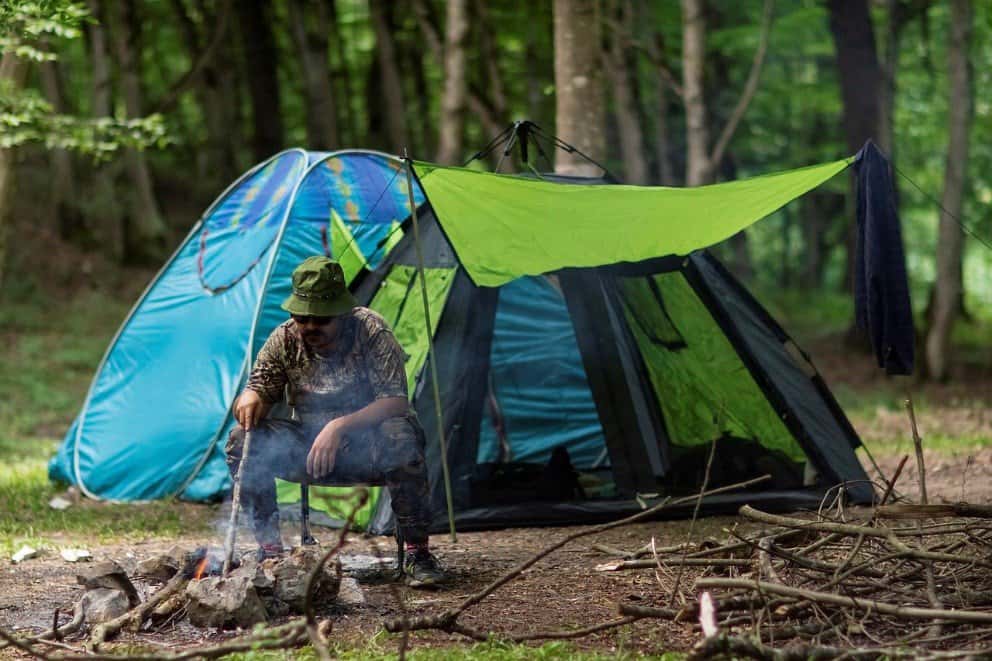
From Dust to Shine: The Ultimate Guide to Cleaning Your Tent

Hiking Gear for Women – 7 Essential Items Every Woman Needs on A Hike

How to Choose a Bivy Sack for Your Next Adventure

The Best Campfire Cooking Kit – Master The Outdoors

Camp Coffee: How to Stay Caffeinated on the Trail

The Best Camping Slippers for Overnight Adventures

Best Summer Sleeping Bags for Backpacking
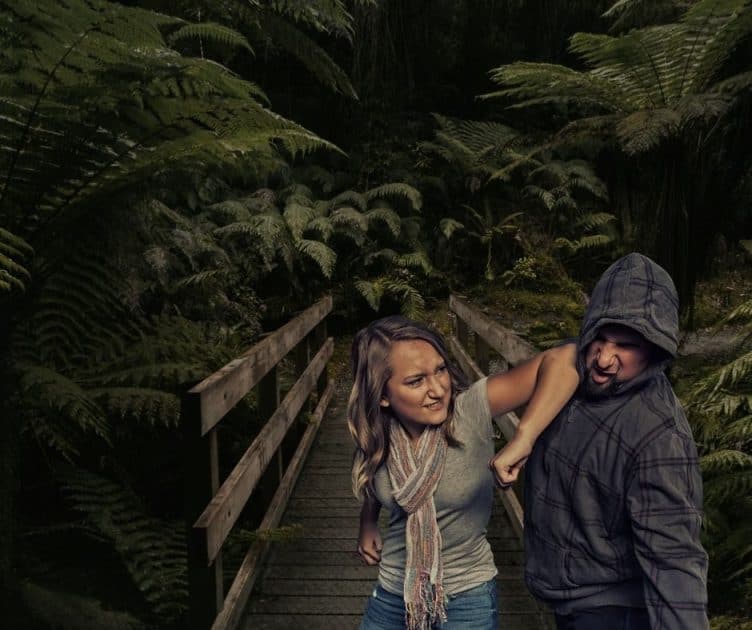
Backpacking Safety Women’s Self Defense Kit

Winter Hammock Camping? How to Stay Warm in a Hammock
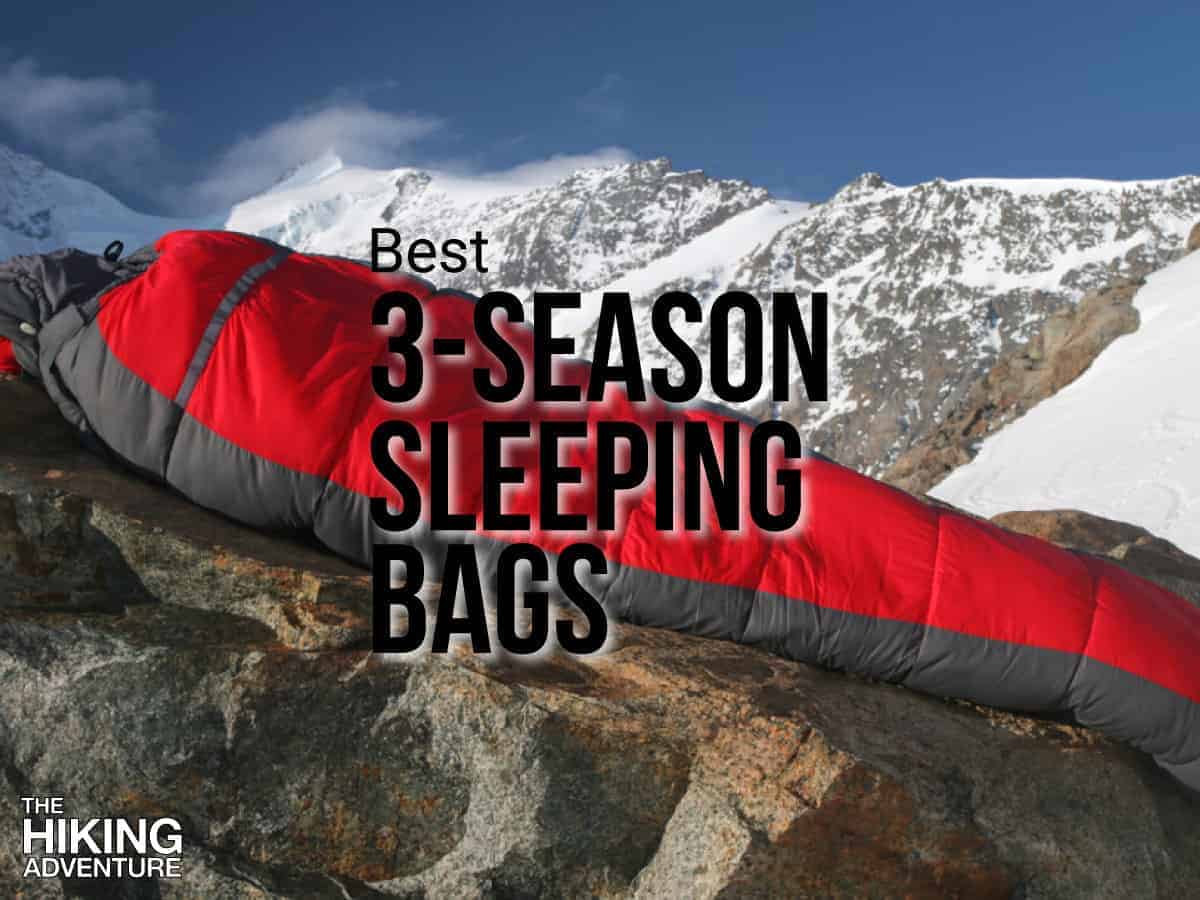
Best 3-Season Sleeping Bags for Backpacking

The Best Tent for Camping With Your Dog [2024]

Best Rooftop Tents for Car Camping Comfort

Best Backpacking Stoves of 2024: Camp Cooking Made Easy & Fun!
Last update on 2024-05-09 / Affiliate links / Images from Amazon Product Advertising API
Atlas & Boots
The UK's most popular outdoor travel blog
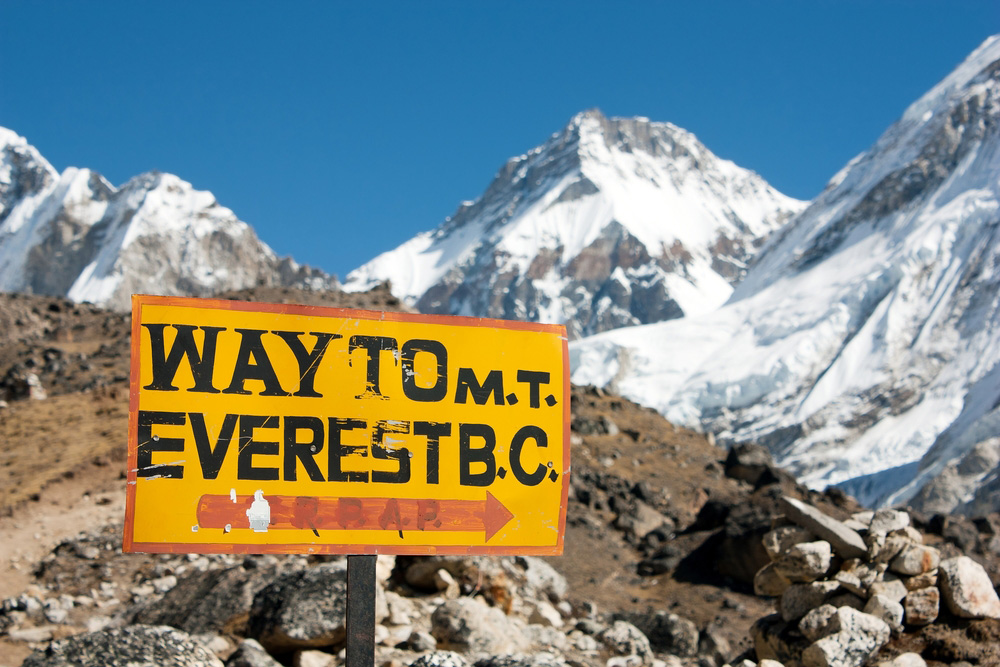
Everest base camp trek tips: 28 things to know before you go
Our Everest base camp trek tips cover everything from permits and teahouses to where to get the best views
I trekked to Everest base camp back in 2019. It was the start of a feverish 24 months of trekking and climbing that took me to the base camps of Earth’s highest and second-highest mountains, across the remote tundra of western Greenland and ultimately to the summit of Aconcagua – the roof of the Americas which, at 6,961m (22,837ft), is the highest peak I’ve ever climbed.
Nepal’s – and perhaps the world’s – best-loved trek is a scenic tour de force. At 8,848m (29,029ft), Mount Everest is the highest mountain in the world. It is one of just 14 eight-thousanders as well as a seven summit . It has captivated intrepid men and women since the first legends of mountaineering made headlines of Everest around the world.
Beyond the epic summits are Sherpa villages, picturesque forests and glacial moraines, all at their best beneath Nepal’s brilliant morning light or blissful evening alpenglow. The route makes use of unparalleled trekking infrastructure with porters and guides taking the heavy loads and cosy teahouses providing soft beds and steaming plates of dal bhat (lentils and rice) along the entire route.
Nepal instantly became one of my favourite countries and I have vowed to return as soon as possible to complete the Annapurna Circuit and Langtang treks. Perhaps one day I’ll go a step further and climb the mountain for real.
Everest base camp trek tips
Given that a few years have passed since my own trek, we asked leading Nepali trekking guides Magical Nepal for their advice on how to get the most from your Everest base camp trek .
Based in Kathmandu, they have a wealth of experience when it comes to trekking throughout the Everest region and the wider Nepali Himalayas as well as Bhutan and Tibet. Together, we have assembled the following list of Everest base camp trek tips you should know before you go.
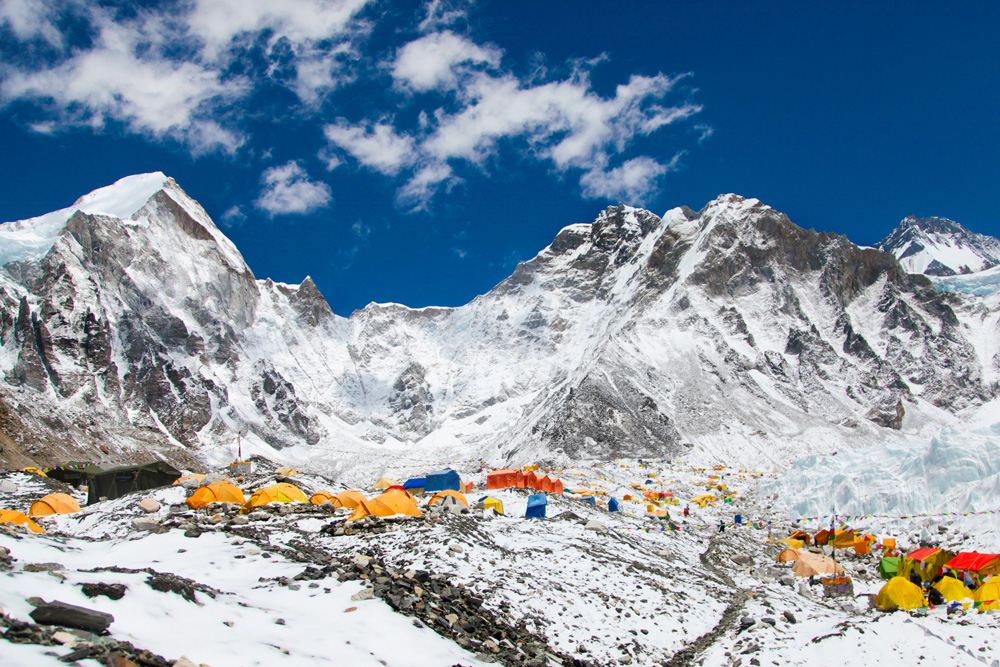
1. At a glance
Duration: 14 days Distance: ~110km Max Altitude: 5,545m (18,192ft) Starts/ends: Lukla Longest day: 19.6 km/7-8 Hours Region: Everest, Sagarmāthā National Park Accommodation: 11 nights in mountain teahouses; two nights in a Kathmandu hotel
2. How long does it take?
An Everest base camp trek typically takes around 14 days which includes 11 days of trekking – although two of these will be acclimatisation/rest days. The trek takes nine days to ascend to base camp and two to descend back to Lukla.
3. How hard is the Everest base camp trek?
On a scale of one to 10, I would say it’s about a six or seven. It is a high-altitude trek, it is for 11 days, you walk for between three and eight hours a day and it can get very cold. It is a challenging trek that shouldn’t be taken lightly.
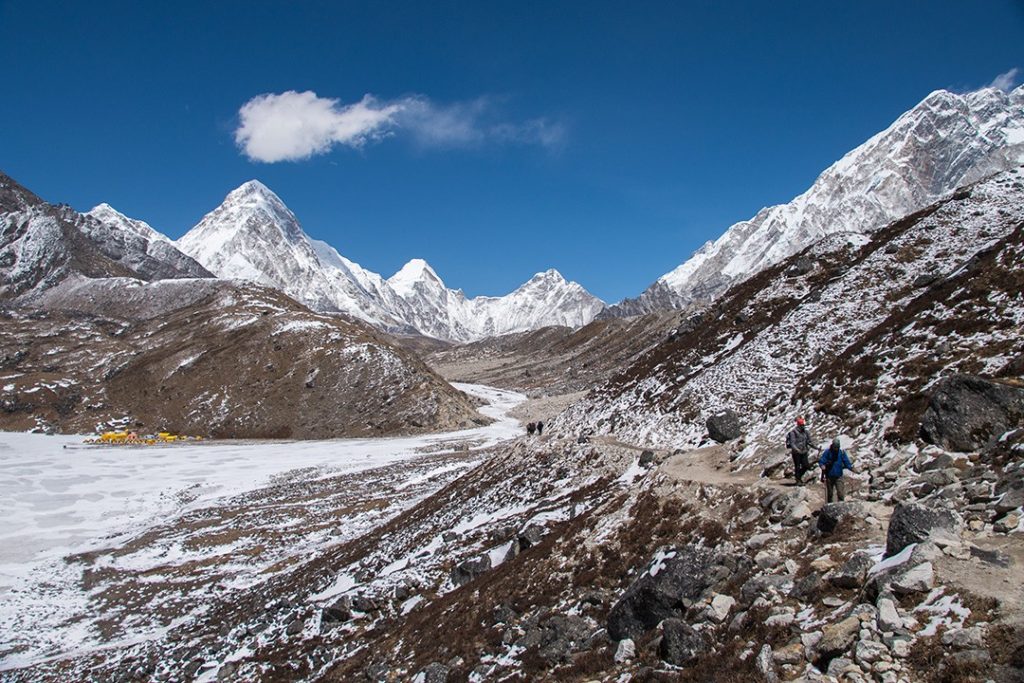
If you have little experience with multi-day trekking or walking at altitude or aren’t particularly fit, then you will find this trek more challenging. A member of our group, a healthy thirty-something man, described it as the hardest thing he’s ever done.
That said, porters carry your heavy gear so your backpack is light, the trail is well-trodden and easy to follow and as long as you take your time and listen to advice, it is a very achievable trek. Every year, over 30,000 people from all walks of life make the trek.
4. How much does it cost and what does it include?
The Everest base camp trek can be booked through Magical Nepal , a Kathmandu-based trekking specialist with a wealth of experience in the region. Prices start from around USD $1,459 for a round trip from Kathmandu and include the following:
- Local transfers for international flights (arrival/departure)
- Local transfers for domestic flights
- Return flight from Kathmandu to Lukla
- Sagarmāthā National Park entry permit and local permits
- Guide for 12 days
- Porters for 11 days
- 2 nights accommodation in a Kathmandu (Bodhi Boutique or similar)
- 11 nights accommodation in mountain teahouses
- 12 breakfasts, 11 lunches and 11 dinners during the trek
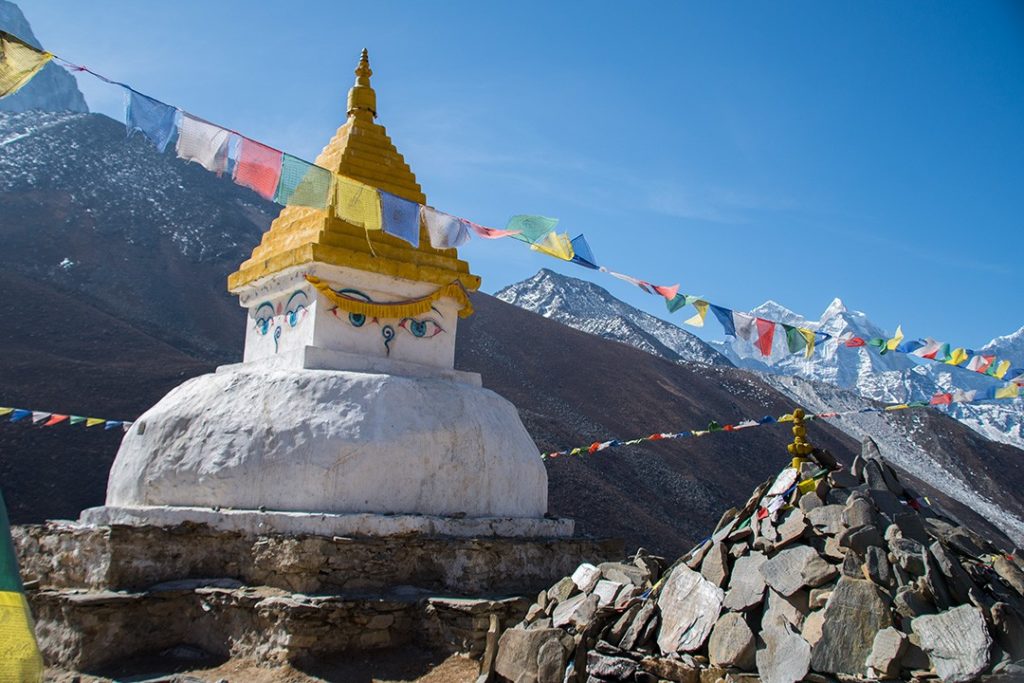
5. How cold does it get?
It depends on the time of year and your location on the trail. The higher you are, the colder it gets. During our trek in early April, it got as cold as -20°C on one night – although most nights were not as cold. The days varied massively. Sometimes we were hiking in shirtsleeves and sweating in the sun while on others we were in cold-weather gear while it snowed.
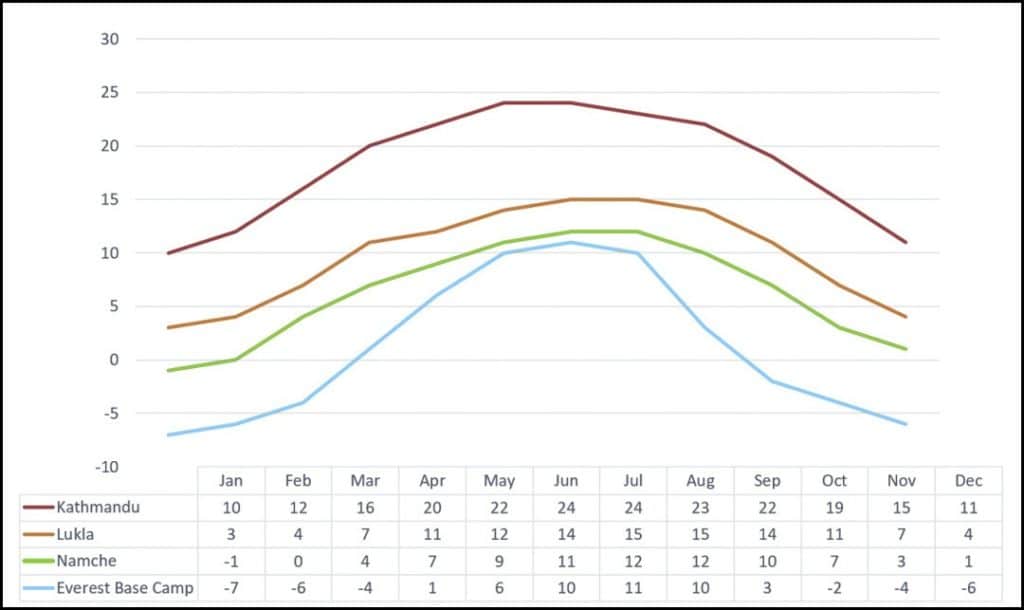
6. When is the best time to trek?
The best time to complete an Everest base camp trek is in autumn (late Sep-Nov). Days are generally dry and clear although there can be the odd shower or storm. This is also peak season so trails are at their busiest.
Another excellent time to trek is during the warmer and quieter spring (Mar-May), which is when I went (early April). This is also the time when the colourful rhododendrons bloom, generally between 2,000m and 3,000m. The drawback is that the dry weather brings dust which leads to hazier days.
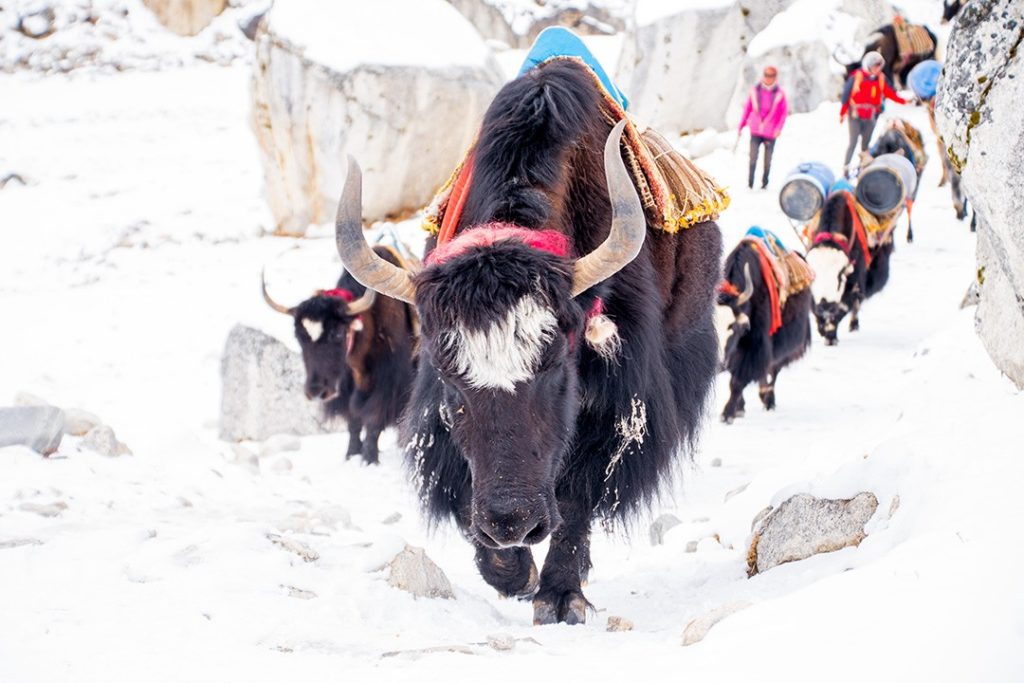
Dec-Feb are good months for trekking, but they are also the coldest and reaching base camp can be a real endurance test. The monsoons arrive in earnest from Jun-Sep, swelling rivers to breaking point, bringing hordes of leeches and making the trail very muddy. Many teahouses will close during these months.
7. Is there snow at Everest base camp?
Absolutely. It’s the base of the highest mountain in the world! It will of course depend on the weather and the time of year, but you should expect to find snow at base camp throughout the year.
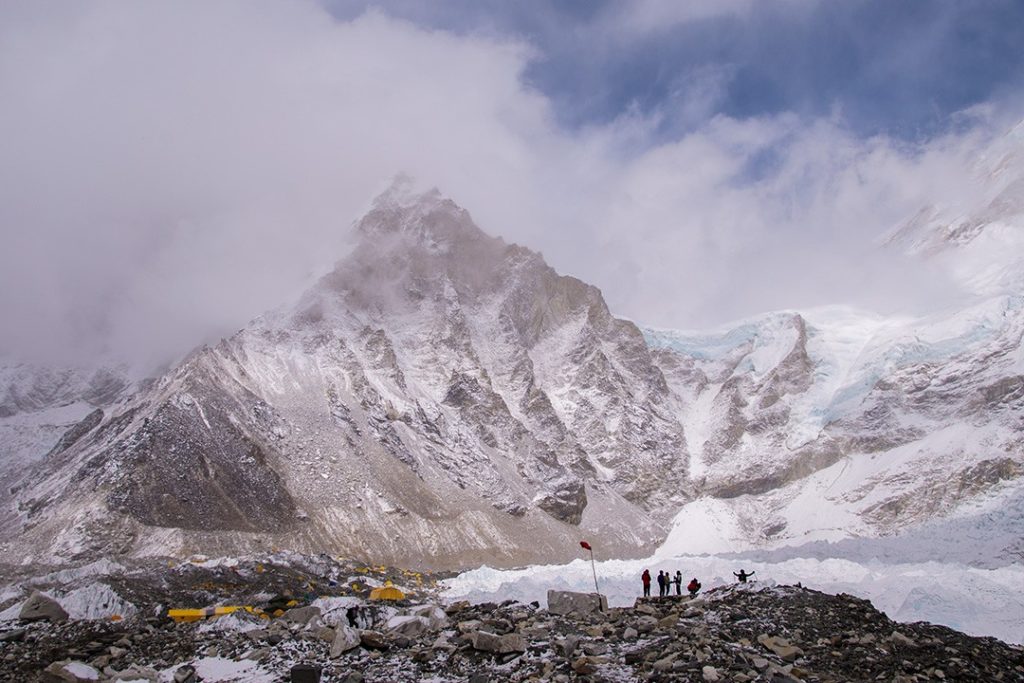
8. What should I pack?
I’ve put together a complete Everest base camp kit list . It contains everything I took with me including clothing, trekking gear, toiletries, medication, electronics and documentation.
9. Can I buy trekking gear and clothes locally?
It is possible to buy (or hire) most items on my Everest base camp kit list on arrival in Nepal. However, I wouldn’t advise leaving it that late and quality can’t always be guaranteed.
Kathmandu does have a host of outdoor shops selling much of what you’re likely to need. There is a collection of imported gear shops – with comparable prices to those in the west – spread along Tridevi Marg near Thamel.
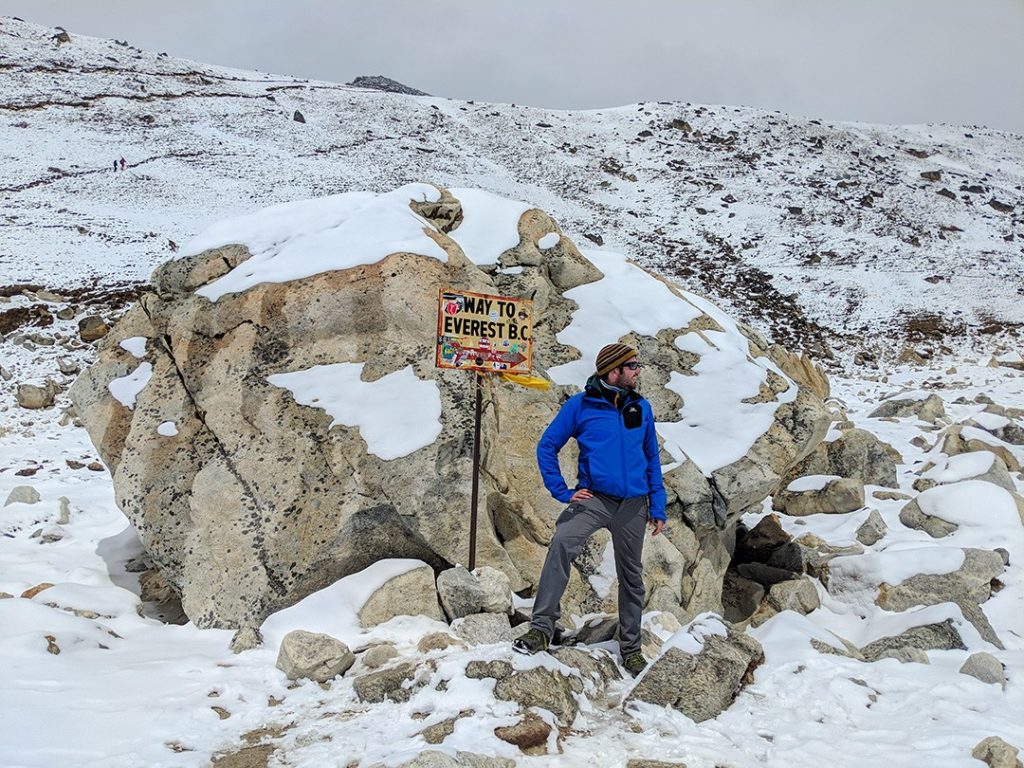
On the trail, Namche Bazaar has some excellent equipment shops including both international ( Sherpa , The North Face ) and local outdoor gear shops as well as countless souvenir shops. There is also a limited assortment of shops and pharmacies in Lukla and other trailside villages en route.
Again, in Kathmandu, it’s possible to hire many items such as sleeping bags and down jackets. Trekkers should always bring their own walking boots and shoes, which should be thoroughly worn in beforehand.
10. What are the weight limits on the flight?
There are strict weight limits on the domestic flight from Kathmandu to Lukla. The flight only allows for 10kg of checked luggage and 5kg of hand luggage. This coincides with the maximum weight porters are allowed to carry: 10kg per trekker with a maximum of two trekkers per porter.
Luggage can be stored securely at your hotel in Kathmandu, but you will need to take all your trekking gear with you. In our Kathmandu hotel, Fuji , there were some luggage scales available for guests to use.
11. What is the flight to Lukla like?
Thrilling! The morning flight to Lukla is spectacular in its own right, with the landing an exciting way to begin the trek. One end of the runway at Tenzing-Hillary Airport in Lukla is 60m (197ft) higher than the other.
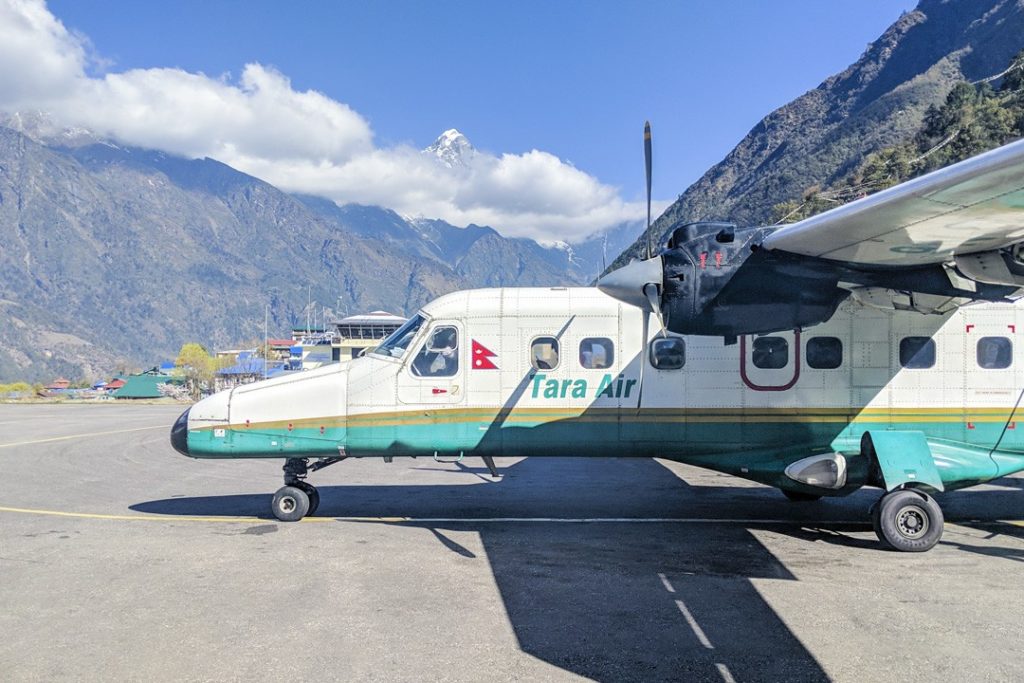
The journey to Lukla takes around 25 minutes by small propeller planes – either Dornier Do 228s or Twin Otters – that seat only 15 to 19 passengers. Spectacular views of the foothills of the Himalayas are on offer, but the weather tends to deteriorate in the afternoon.
If you suffer from travel sickness, I would advise taking some medication. At least one member of our group wished they had! Airsickness bags are provided on the flight.
12. How much should I tip guides and porters?
Tipping when travelling can be a bit of a quagmire, but the guides and porters on the trek deserve every penny they earn and then some. We suggest the following when it comes to tipping local support staff.
- For the head guide between $20-30 USD per client, per week.
- For porters during the trek $4-7bUSD per group, per day.
- For drivers and local guides $1-$2 USD per client, per day.
We had a head guide, assistant guide and five porters supporting our group of 11 clients. Our guide and assistant guide were with us for 15 days and the porters for 12 days.
We each contributed around $150 USD to the tip fund which was divvied up as follows:
- Head guide: $60 x 11 = $660
- Assistant guide: $30 x 11 = $330
- Porters: $60 x 11 = $660 / 5 porters = $132 each
We also collected a few dollars each for our head porter as he was particularly helpful and even invited us to his wife’s teahouse during the descent for snacks and tea.
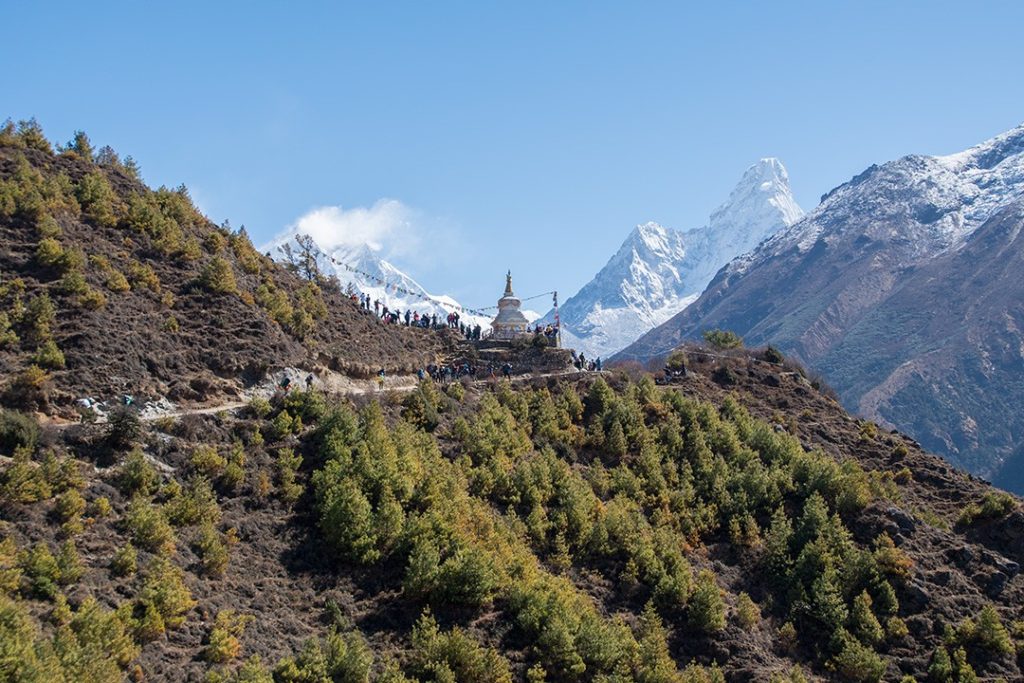
13. Can I charge my phone and camera on the trail?
It is possible to charge appliances at teahouses, but this usually incurs a charge starting from 100 NPR ($1 USD) at lower altitudes and rising to 500 NPR ($5 USD) higher up the trail. Some teahouses charge more for charging a powerbank or camera. I think the most I heard someone paying was 700 NPR ($7 USD) for a large powerbank.
Some cafes on the trail will allow you to charge a device for free if you’re buying a meal or drink.
14. Is there wifi available?
Wifi is available at many villages along the trail. However, these are some of the most remote villages in the world so connection is often interrupted or very slow – particularly when groups of trekkers arrive at the same time and all connect simultaneously!
Again, wifi costs increase as you ascend. Generally, at lower levels, it starts from around 100 NPR ($1 USD) to connect at a teahouse overnight and increases as you get higher.
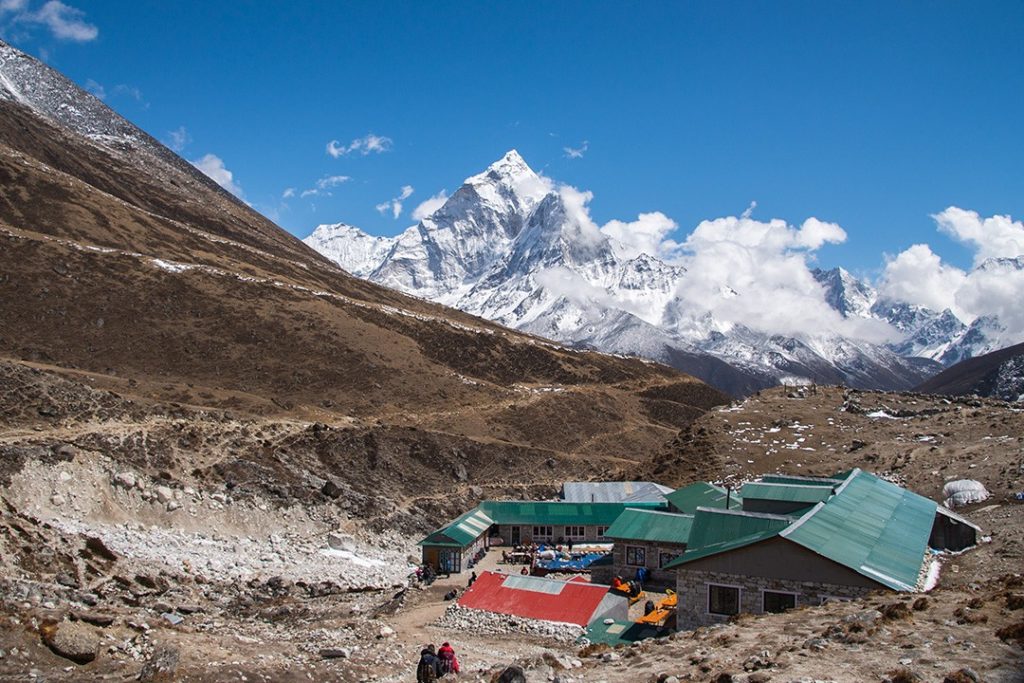
The most reliable connections are the Everest Link hotspots available at most of the villages. These prepaid cards are available in 10GB and 20GB for 1,999 NPR ($20 USD) and 2,999 NPR ($30 USD) packages and last for 30 days. Cards can be bought in Kathmandu, Lukla, Namche Bazaar and in some of the smaller villages.
15. Is there phone reception?
Phone reception is of course intermittent, but there is reception at the lower villages. I made the mistake of buying a Nepal Telecom ‘Namaste’ SIM card at the airport on arrival. However, this didn’t have reception from Namche Bazaar onwards. The Ncell networ k , which my guide and some other trekkers had, appeared to have better reception further up the trail and my guide recommended them.
Both providers have outlets at the airport and throughout the country and offer a range of data packages. You’ll need a copy of your passport and a photo to obtain a SIM card.
Another option is to get a Holafly eSIM for Nepal so you can stay connected to the internet on your trip. We can offer our readers 5% off Holafly purchases. Simply use the code ATLASANDBOOTS at checkout.
16. Is it safe to drink the water?
Yes, it is safe to drink water as long as you use purification tablets. Nearly all teahouses and restaurants can provide drinking water free of charge. Only at Gorakshep (the last stop before base camp) was it necessary to buy bottled water, as there is not a natural spring nearby.
Otherwise, do not buy bottled water or bottled soft drinks on the trail. Plastic bottles are difficult to dispose of and have become a serious environmental problem.
17. What is the food like?
The food is actually pretty good along the trail. For lunch and dinner, every teahouse serves the traditional Nepali Dal Bhat (rice and lentils) as well as a variety of meals such as rice, vegetables, noodles, potatoes and soup along with Nepali versions of western food such as pizza, pasta, sandwiches and veggie burgers.
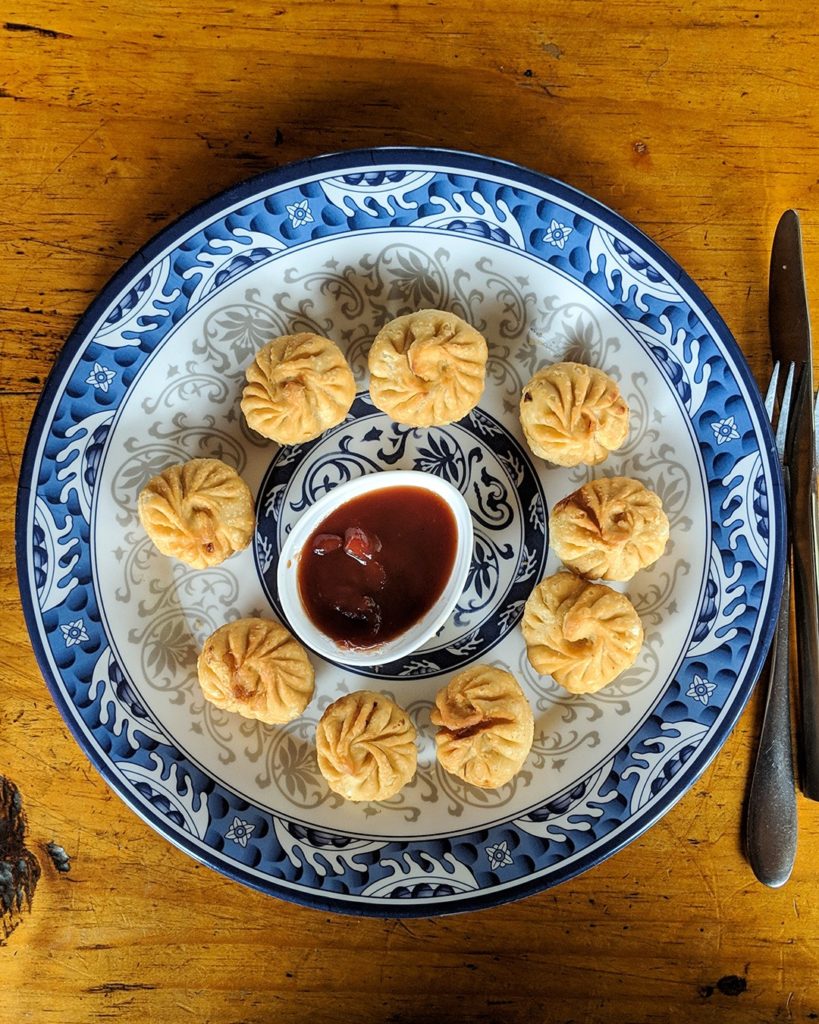
The food on the trail was tasty and varied
Breakfast is usually a choice of porridge, various styles of eggs, toast, pancakes or the delicious (but sweet) Tibetan bread.
Do not eat meat along the trail, particularly higher up, as it has to be flown into Lukla and then transferred up the trail. Additionally, refrigeration cannot be relied upon.
Regardless, it’s much better to stick to a carb-heavy vegetarian diet as it’s just what you need on a long high-altitude trek such as this.
18. How much do meals cost?
I found I was spending around $20-30 USD per day on food, hot drinks and snacks – and that often included a fee for charging a device, a hot shower or wifi.
However, if joining an organised trek, all meals along the trail are usually included in the price so you only have to pay for your meals in Kathmandu.
If you’re travelling independently, allow for between $400-600 USD in total for meals along the trail. The cost of food and drinks gets more expensive the higher you trek.
19. Can I take a shower during the Everest base camp trek?
There are some hot showers at teahouses on the trail at an additional cost ($3-5 USD). I took two hot showers during the trek. The rest of the time I just had cold-water washes.
Only have showers at teahouses with solar heaters. Don’t use water heated by wood, as a lack of firewood in villages is a big environmental concern in Nepal. Your guide will be able to advise you.
20. Is the Everest base camp trek dangerous?
All high-altitude treks involve a certain degree of risk. However, if you follow these Everest base camp trek tips, along with the advice of your guide and adhere to the set acclimatisation itinerary, then most healthy people will complete the trek without any serious issues.
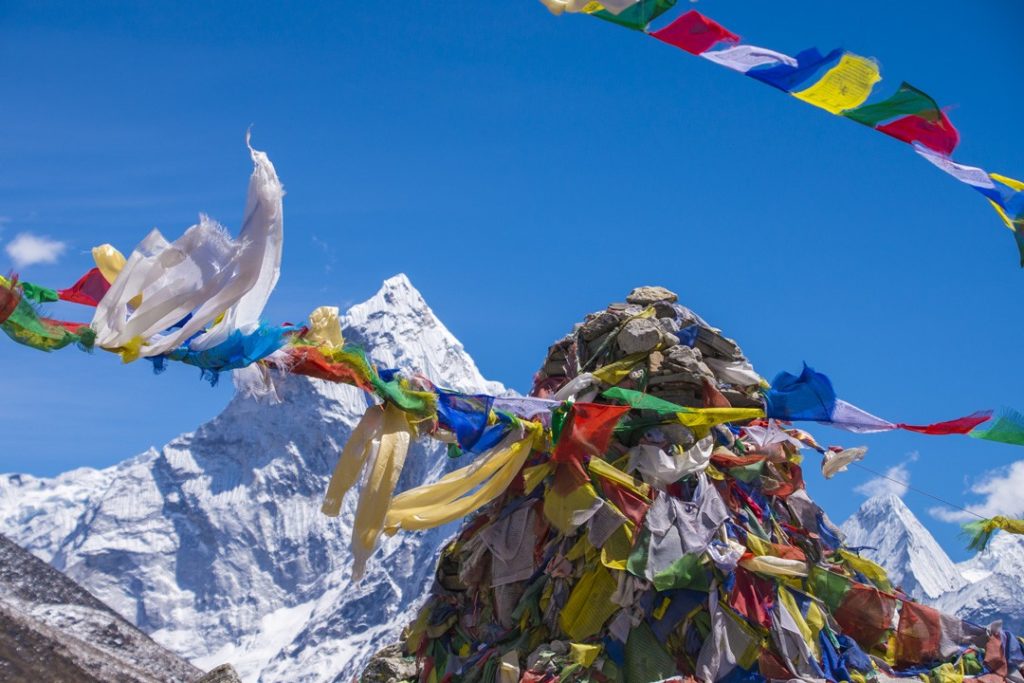
The important thing with high-altitude trekking is to not rush, go at your pace and listen to your body. Read our detailed guide on how to identify, treat and prevent altitude sickness symptoms .
21. Should I take Diamox?
This is very much down to the individual. I didn’t take Diamox, but I have been up to this altitude several times before so knew what to expect. However, I did have some with me in case I felt bad at the higher altitudes.
The best advice I can give is what trekking guides have told me in the past. Have some Diamox with you and take it as soon as you start to feel the pulsing headaches that are synonymous with altitude sickness . He said it’s good to have some available at the higher altitudes – particularly at Gorakshep where you sleep at 5,300m – so you can use it to help you get a good night’s sleep.
22. Do I need sunscreen?
Yes! Despite the cold, the sun is intense. Make sure you wear sunscreen with an SPF of at least 40, lip balm with SPF protection, sunglasses and a sunhat.
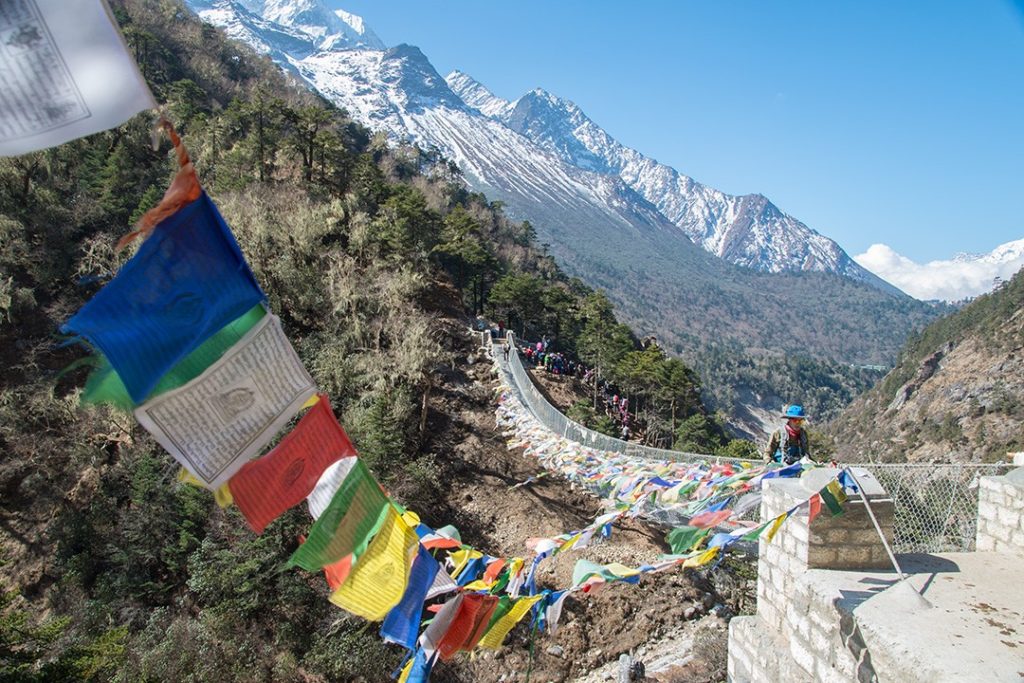
23. What sort of travel insurance do I need?
One of the most important Everest base camp trek tips is to make sure you select a travel insurance policy that has sufficient medical coverage. It must have a minimum coverage of $200,000 USD for repatriation and emergency rescue. Make sure you check how your policy covers ‘dangerous activities’ such as trekking at altitude and mountaineering.
It must cover the possibility of a helicopter evacuation for trekkers and general medical evacuation to Bangkok or Delhi, which alone can cost $40,000 USD.
24. Do I need a trekking permit?
To trek to Everest base camp you must enter Sagarmāthā National Park where you will need to pay a national-park fee. For foreigners, not from a South Asian Association for Regional Cooperation (SAARC) country, the fee is 3,000 NPR ($30 USD) per person. A full list of park entry fees in Nepal can be found here .
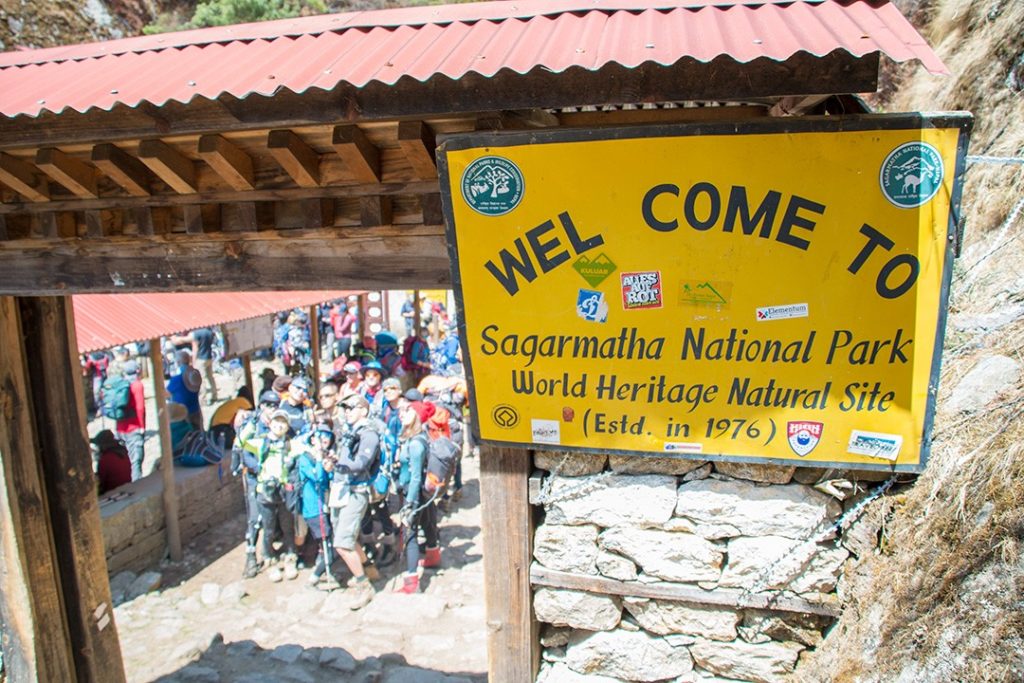
If you’re joining an organised trek, the fee should be included in the trip cost.
25. Are the teahouses warm?
There is usually a large dining room-cum-lounge with a stove in the centre where trekkers hang out in the evenings. The stove is usually lit in the early evening so the room gets pretty cosy.
However, the bedrooms remain chilly, to say the least. A blanket is often supplied which, combined with your sleeping bag, means you should be warm enough once safely cocooned in your bedding. The cold certainly never stopped me from getting a good night’s rest.
26. Can I drink alcohol along the trail?
There are teahouses, restaurants and even bars in the villages along the trail that serve alcohol. However, I wouldn’t recommend drinking any alcohol until you’re on your way down.
Some members of our group drank alcohol on the way up and they all suffered for it. On the way down you’ll be accustomed to the altitude and in a far better state to enjoy a snifter or two.
Furthermore, drinking higher up the trail just encourages demand. All those cans of beer you don’t need have to be carried on the backs of porters and yaks.
27. Can I see Everest from base camp?
Yes, although because of the angle it is somewhat obscured by Lhotse, Nuptse, the West Shoulder and the South Col. The best views of the Everest massif and the Khumbu Icefall are from the nearby summit of Kala Patthar.
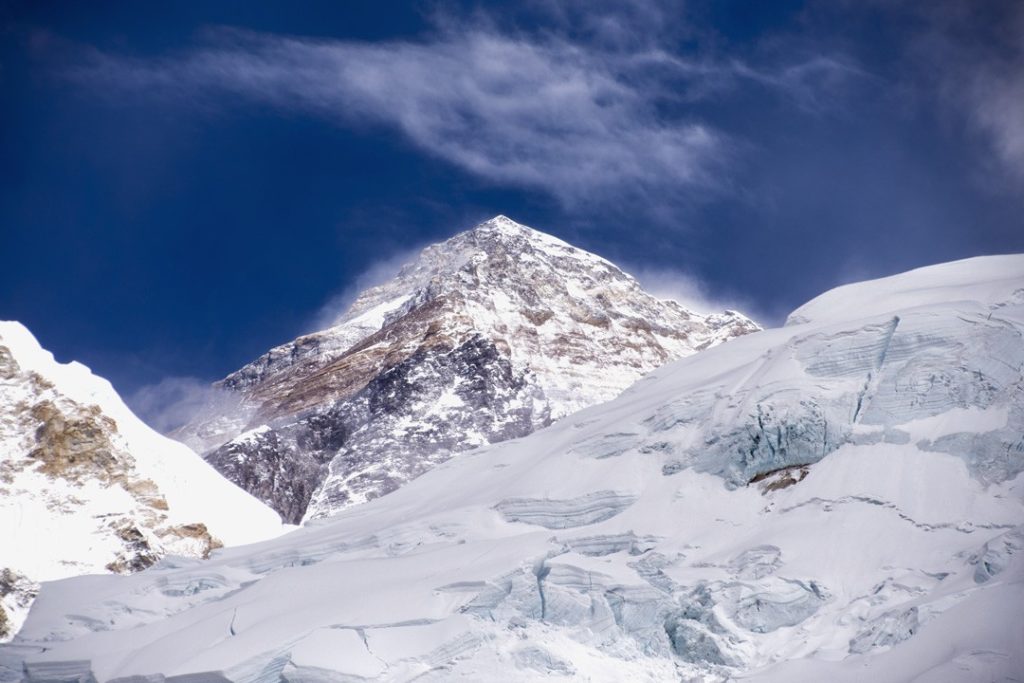
On my trek, no one fancied the optional early morning hike up Kala Patthar, so I dragged myself out of bed and headed off alone. I didn’t have enough time to make it to the summit, but I got as high as the plateau which still offered some excellent views. The wind was lashing and it was ferociously cold, but I do regret not getting up a bit earlier and making the full ascent.
28. Is the Everest base camp trek worth it?
Without a doubt, yes.
After over 100km of high-altitude trekking amid soaring peaks, Sherpa villages, picturesque forests and glacial moraine concluding at the foot of the world’s highest mountain, I can safely say the experience was everything I hoped it to be.
Enjoyed this post? pin it for later…
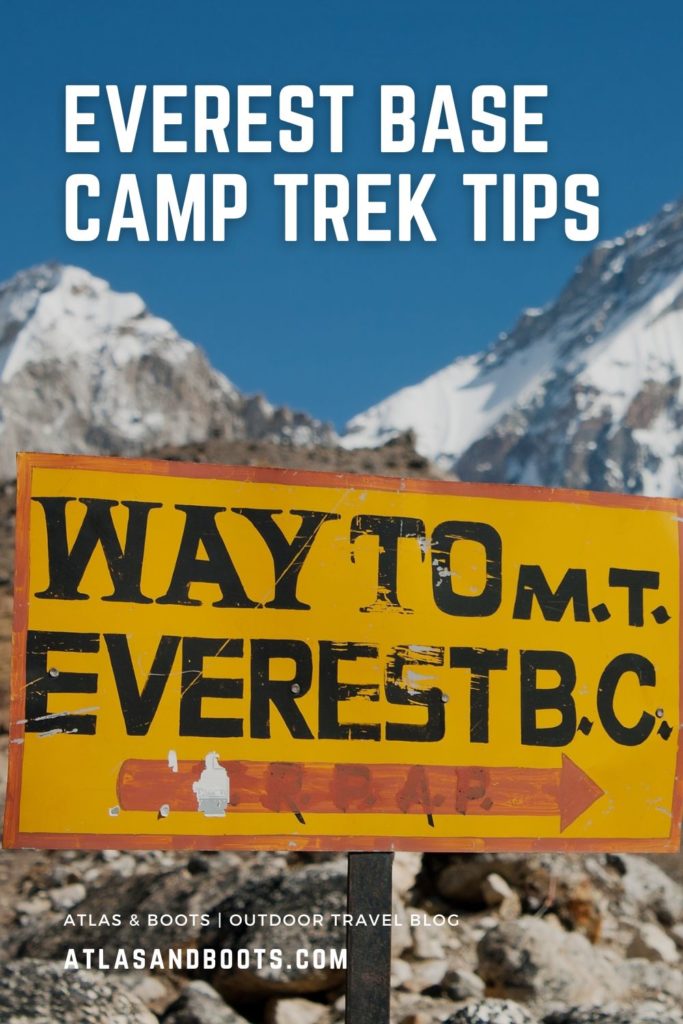
Lead image: Daniel Prudek/Shutterstock
You might also like:.
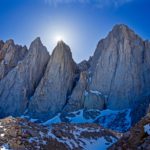

IMAGES
VIDEO